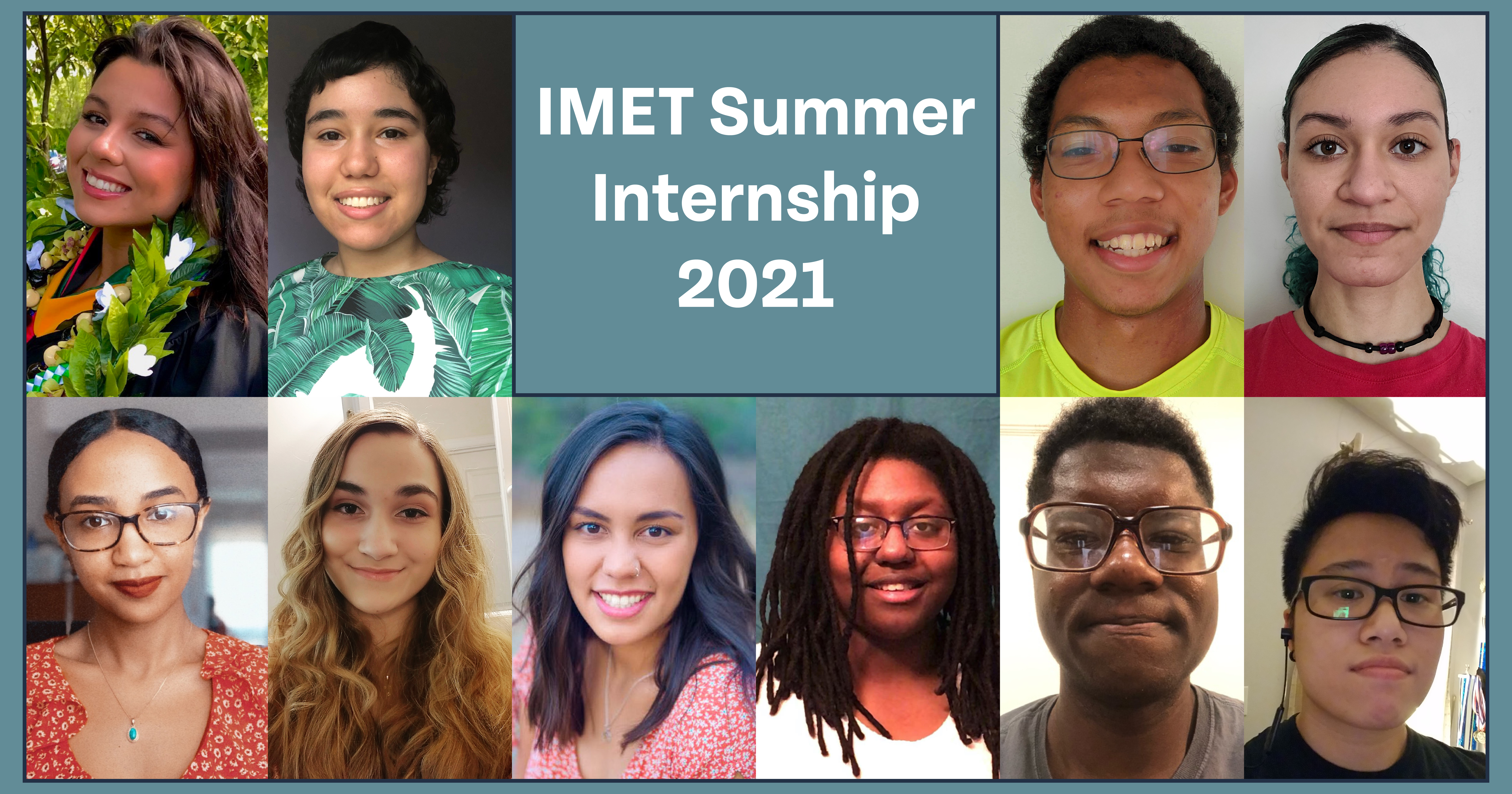IMET Summer Internship
June 7 - August 6, 2020
Week 8: The Finale
On Friday, July 30, the interns gave their final presentations, demonstrating the skills they have built as scientists and communicators. The day began with remarks from Dr. Rosemary Jagus, who has directed the program since 2001. She remarked on the caliber of the interns’ research and gave a brief history of the program and why it is vital to encourage a diverse group of students to pursue marine and environmental science.
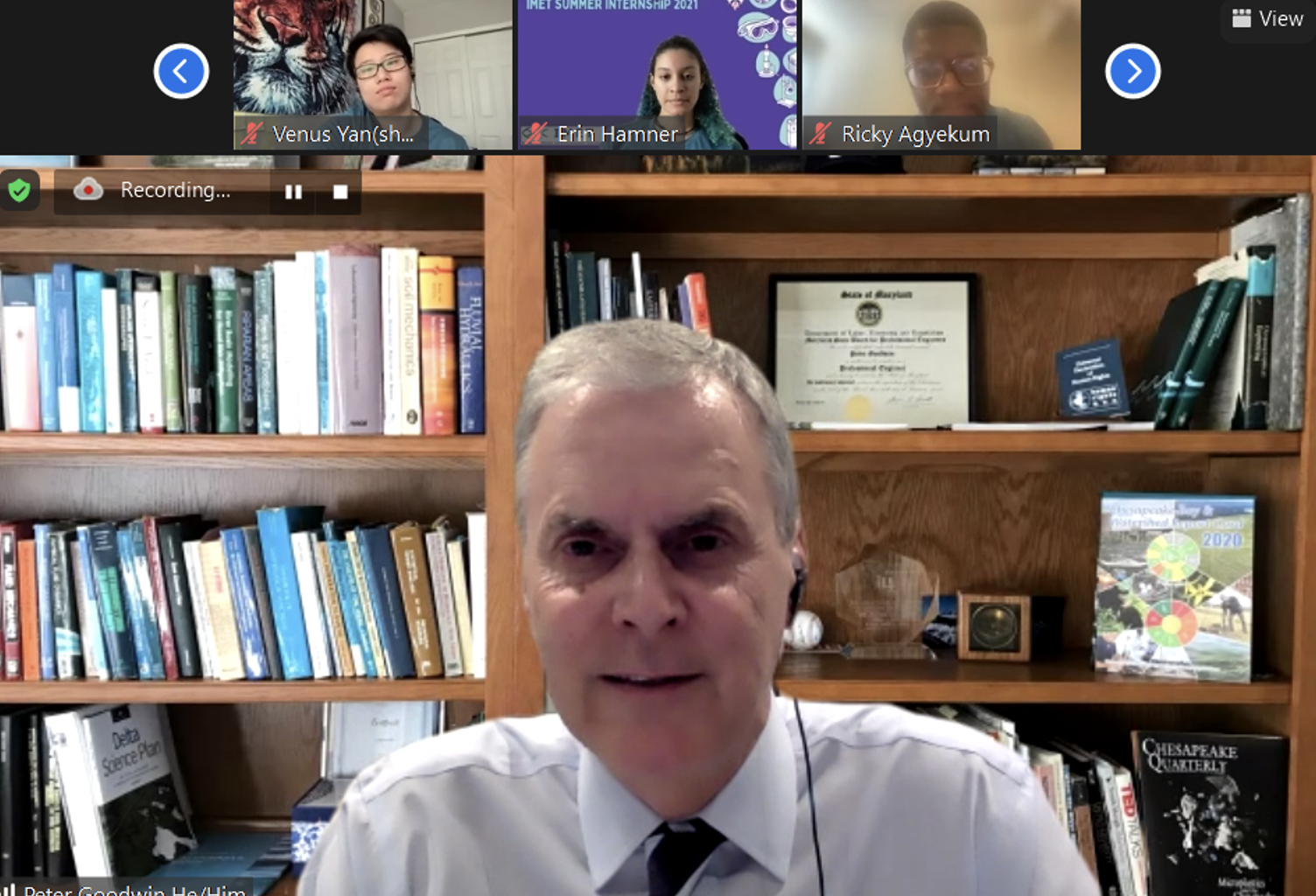
The interns were joined by Dr. Peter Goodwin, President of the University of Maryland Center for Environmental Science, who complimented them on their efforts and gave them a charge to consider pursuing careers in the environmental sciences.
Dr. Russell Hill, traveling many time zones away, sent a pre-recorded message congratulating the interns and asking them to stay in touch throughout their careers. Then, we got to the part we’ve been building up to for 8 weeks: final presentations!!
Ricky Agyekum and Erin Hamner: Deteriorating water quality in the Baltimore Harbor: a view from 2019-2020 | Dr. Eric Schott and Abdul Adaranijo
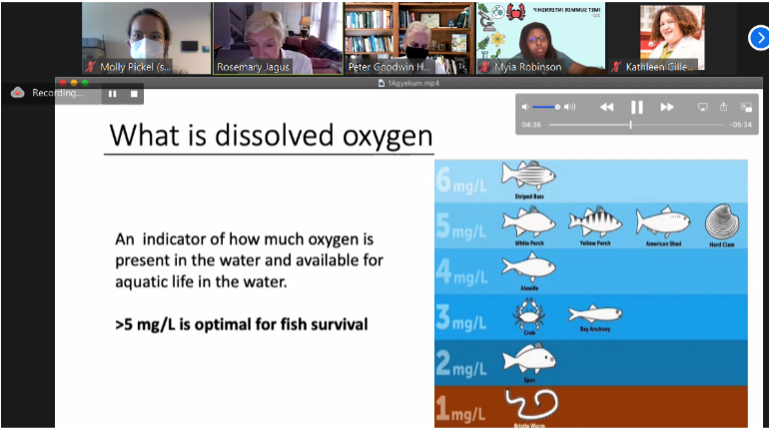
Ricky and Erin both examined environmental indicators and conditions in and around Baltimore’s Harbor to determine whether the water was fishable or swimmable in 2019 or 2020. Ricky analyzed data on chlorophyll and dissolved oxygen to understand how well fish could survive. Chlorophyll levels are high when there are algal blooms, which in turn can cause periods of extremely low dissolved oxygen. In these conditions, fish cannot survive. In the two years Ricky analyzed, he found no improvement in the sites he studied, although the shallower site (Masonville Cove) had the most favorable conditions for fish life. Ricky is double majoring in Political Science and finds both the scientific and political aspects of water quality improvements interesting.
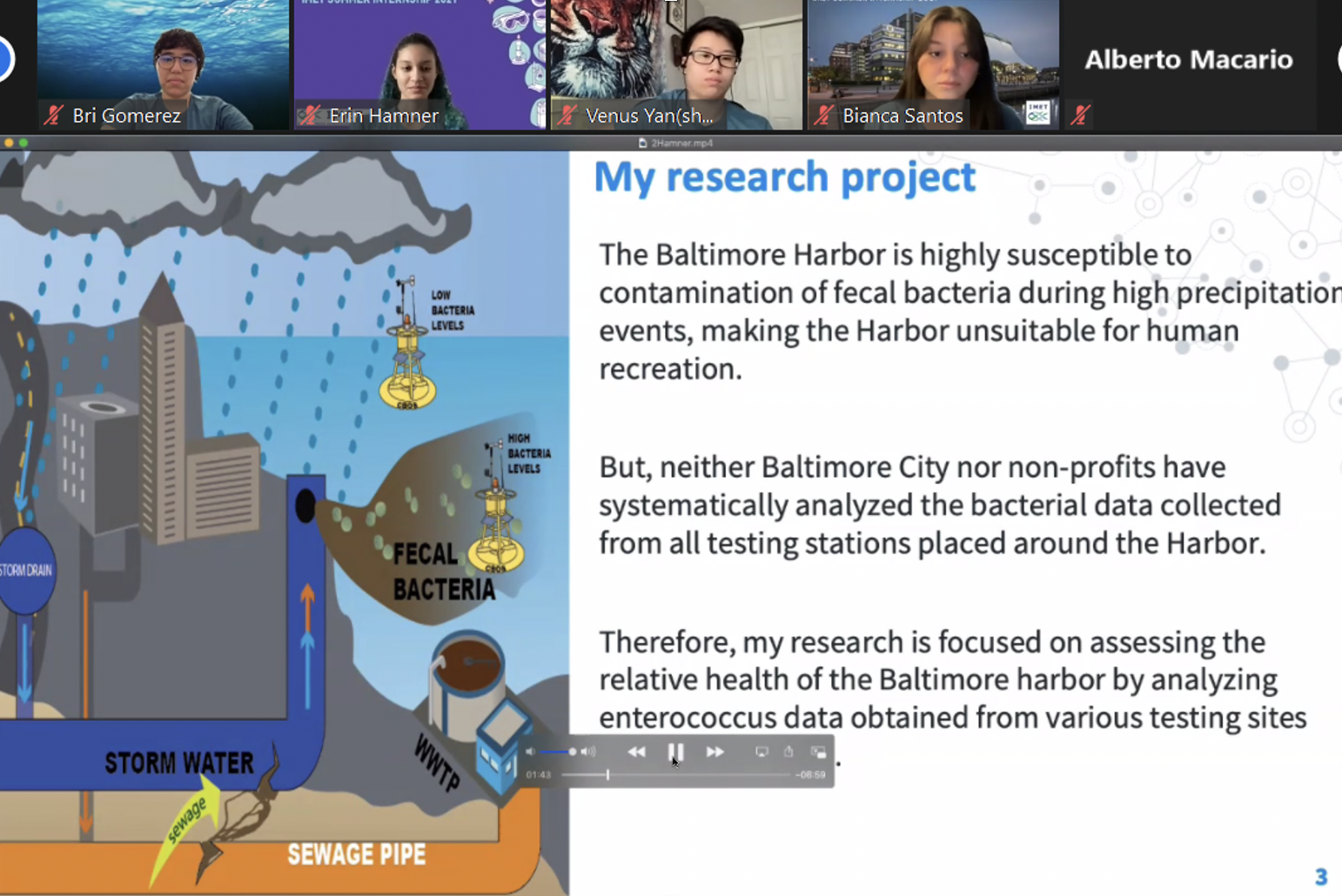
Erin examined fecal bacteria in the harbor, a serious public health concern. In the slide pictured, she demonstrates the communications skills she built this summer. In the conceptual diagram, she illustrates how fecal bacteria enters the harbor – through seepage from sewage pipes to storm water drains – and in the text, she shares an ABT explanation of her work. One conclusion she drew from her data analysis was that bacteria had declined in the Jones Falls watershed, but not in the Gwynn’s Falls. More investment has been made in improving the Jones Falls through sewage infrastructure updates. This indicates that our efforts are having a positive effect, but also brings up some of the political aspects of the water quality issues – why has the Jones Falls been the focus and does the Gwynn’s Falls need additional attention?
Bianca Santos and Brianna Gomerez: What’s for dinner? How biodiversity in Baltimore’s Inner Harbor sustains blue crab diets | Dr. Eric Schott and Olivia Pares
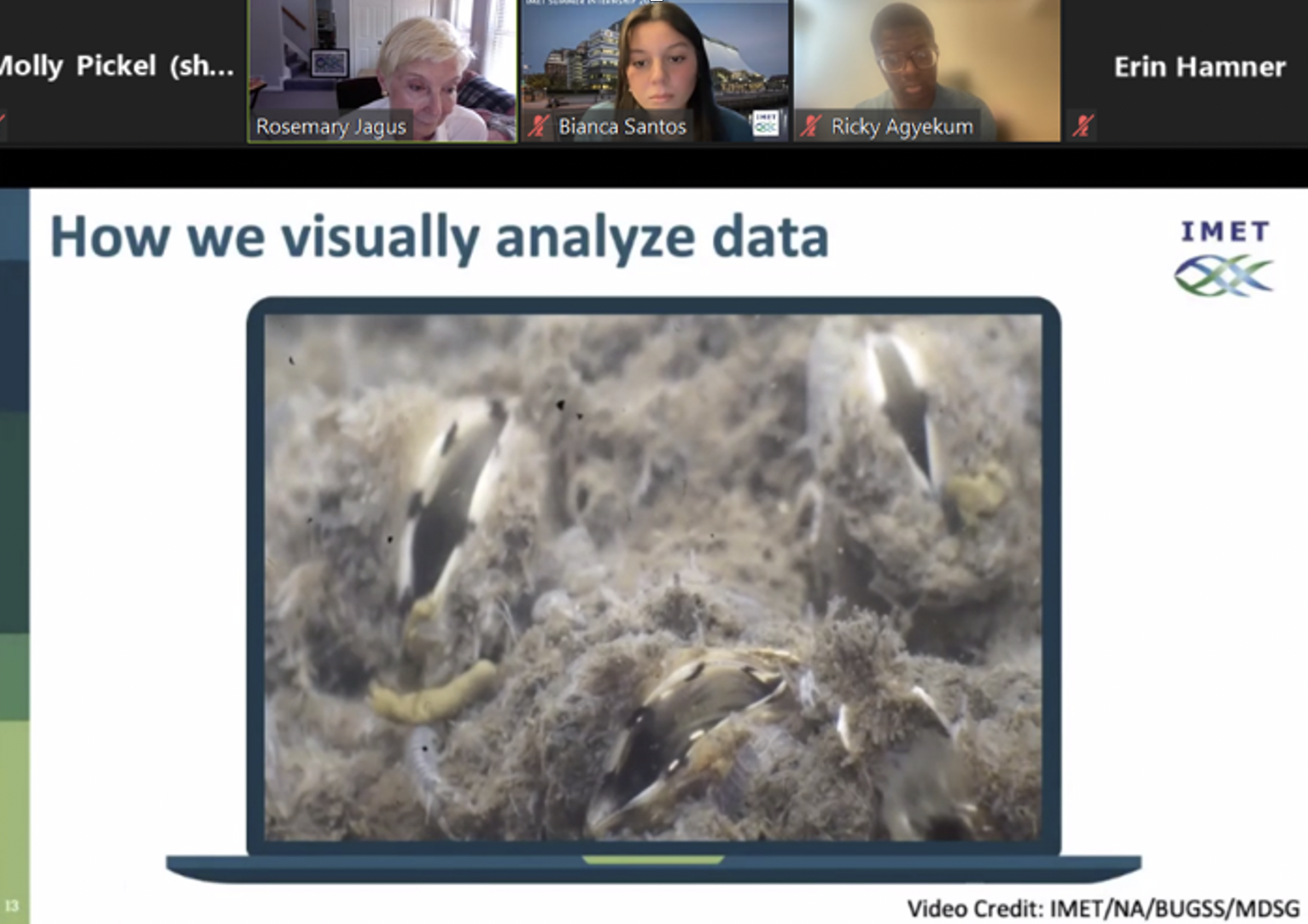
Bianca and Brianna looked at the biodiversity of Baltimore’s Inner Harbor using video and bioinformatic data. Bianca showed some of the videos taken of organisms that grew on biodiscs placed in the harbor. These biodiscs create surfaces where small organisms can grow. There are a variety of bryozoans, mussels, worms, barnacles, and other estuarine species. Overall, she reported that bryozoans were the dominant taxa at all the sites she analyzed. While the Inner Harbor is not the most biodiverse ecosystem, she did find that there are plenty of organisms that are able to make their home there and contribute to a food chain that supports the blue crab, the focus of Brianna’s project.
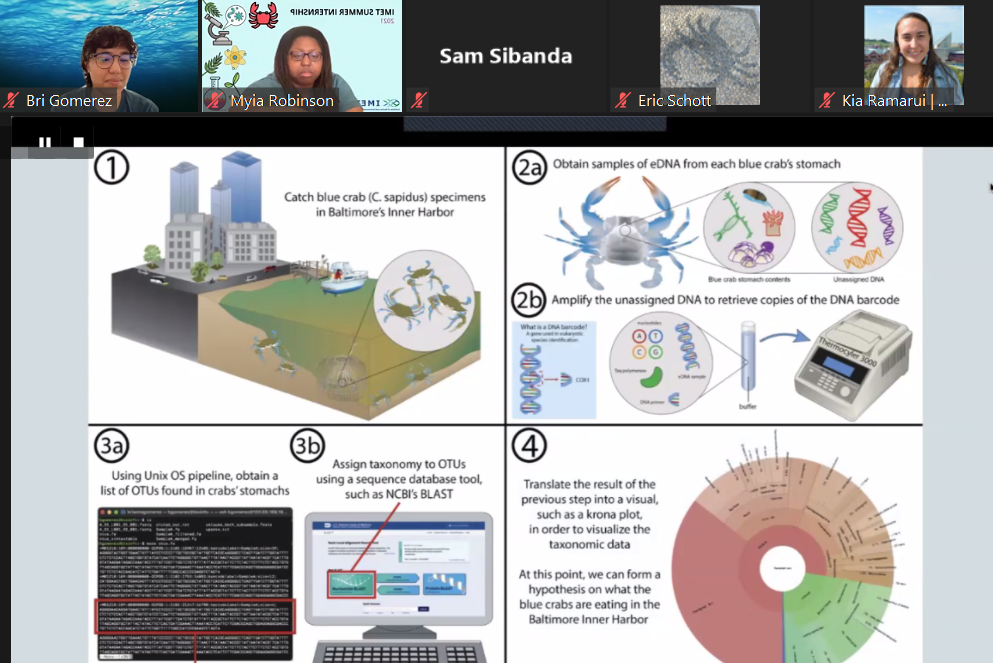
Brianna studied DNA sequences from samples of blue crabs’ stomachs, seeking to determine the contents of their diet. This is a relatively novel, but potentially powerful, approach and there are still technical challenges to be worked out. Using DNA metabarcoding, Brianna found that most of the sequences were from the blue crab itself. There were a few other sequences present, including that of whip mudworms and diatoms, but there was too little data to draw a complete picture of the blue crab diet. Brianna finished her presentation with recommendations for changes to the methods that might lead to elucidation of the blue crab’s diet. She gained valuable experience using databanks like Midori and GenBank, that will help her in future endeavors.
Myia Robinson and Eric Sibanda: Emersion of blue crab leads to changes in the expression of stress pathway genes | Dr. Tsetso Bachvaroff and Anya Byrd
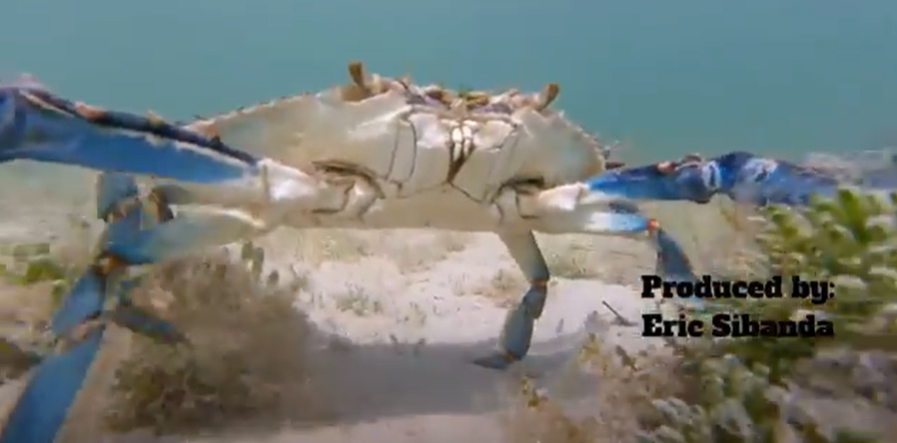
Myia and Eric studied mTOR, which is a key regulator of cellular pathways in animals, including the blue crab. They wanted to know how blue crabs respond to stressors like low oxygen (hypoxia) and no oxygen (anoxia). Throughout the summer, Eric has entertained the group of interns with funny and well produced videos. He delivered again for his final presentation, creating an engaging video presentation that demonstrated all he had learned about communicating science.
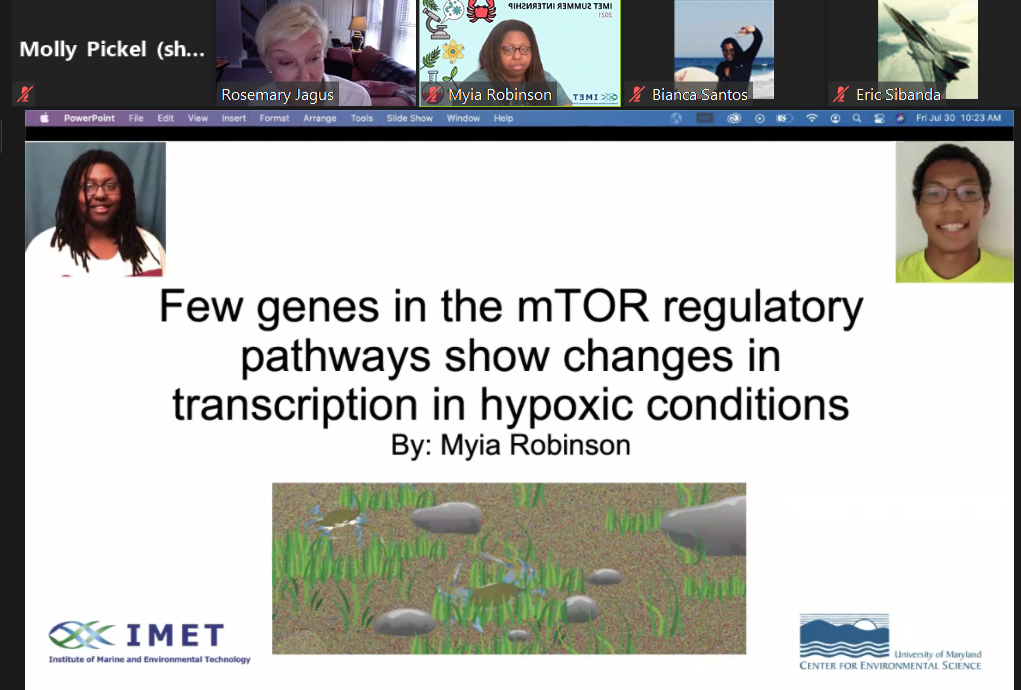
Myia found that mTOR transcripts were present in both condition, but some mTOR pathway genes were downregulated in hypoxic conditions. Myia and Eric both worked with graduate student mentor Anya Byrd, who is studying mTOR in blue crabs for her PhD. The work that the interns completed this summer will help her further her research.
Venus Huang and Lizi Cudal: Comparing microbial communities between Baltimore Harbor and open oceans | Mentor: Paulina Huanca
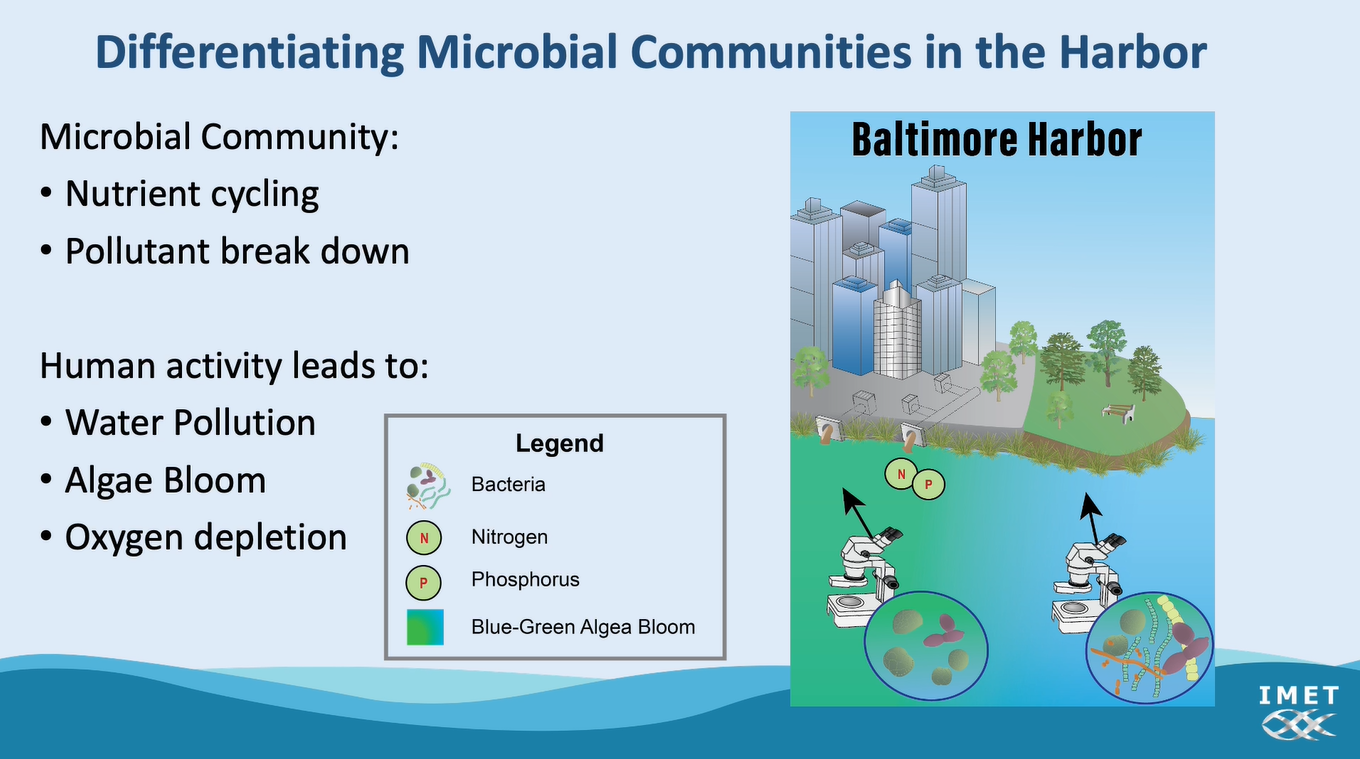
Venus and Lizi used similar methods to analyze huge DNA datasets on microrganisms in the harbor and ocean. Venus focused on data collected in the Baltimore Harbor, while Lizi looked at data collected by Tara Oceans, an organization that seeks to characterize global microbial diversity in the open oceans. Venus found that the most common microbes in Baltimore’s waters were Oxyphotobacteria and Gammaproteobacteria and that there were sometimes pathogenic bacteria present, likely indicating sewage seepage.
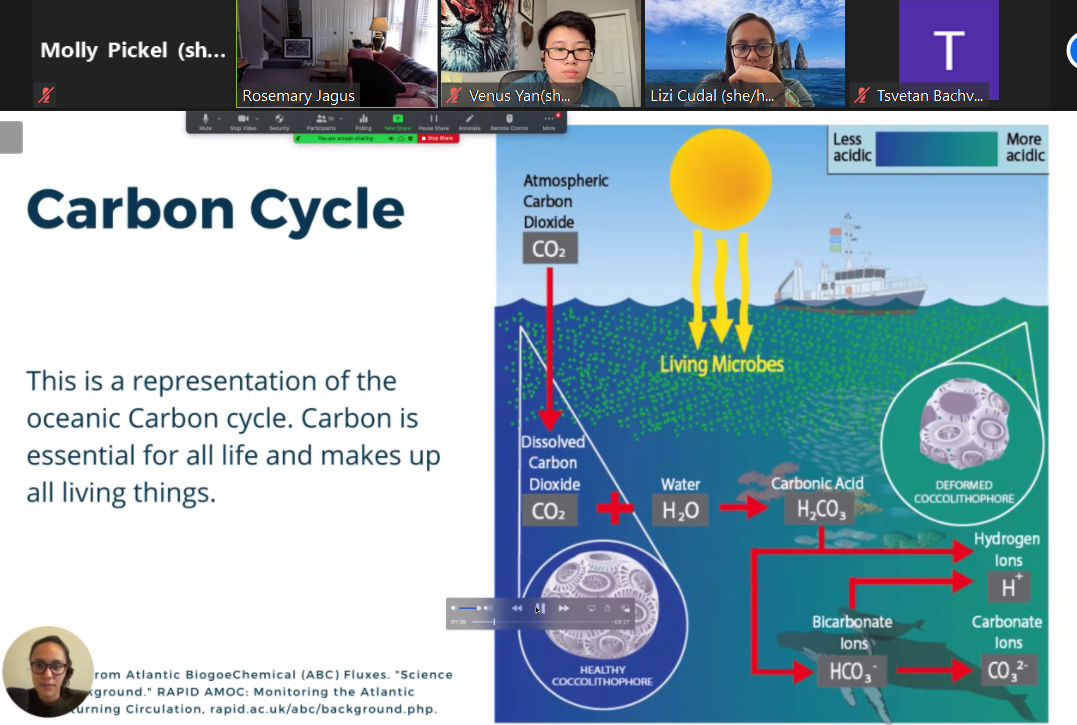
Lizi began her presentation by explaining the importance of microorganisms in the ocean; they are responsible for maintain the carbon and nitrogen cycles, regulating ecosystems and even our climate. She characterized the microbial diversity at two ocean sites off the Atlantic coast. She found abundant Proteobacteria, Euryarchaeota, Bacteroidetes, Deferribacteres, and Thaumarchaeota, which are important for nitrogen cycling. Together, Venus and Lizi were able to show differences in microbial diversity between near-coast, urban sites and open ocean sites.
Jenny Lenhoff and Gelila Begashaw: Harnessing the power of bacteria and archaea to solve environmental issues | Mentors: Dr. Tsetso Bachvaroff and Lauren Jonas
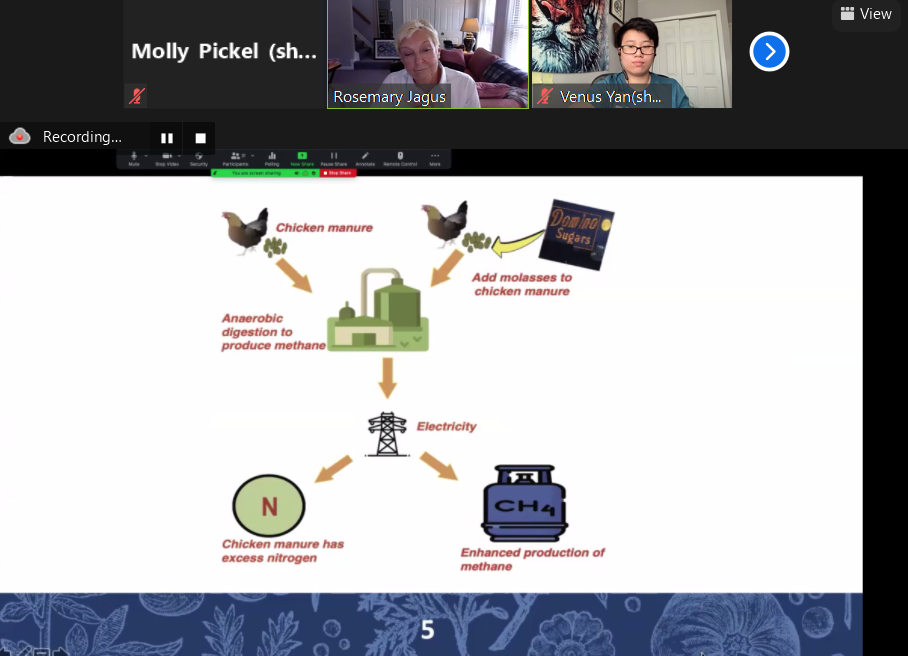
Jenny and Gelila investigated the possibility of using an abundant resource – chicken manure – to produce a resource in high demand – biofuel. To do this, they searched for methanogens, methane-producing microbes. Gelila investigated the impact of adding molasses to chicken manure on methane production. She found that this addition greatly increased the amount of methane produced by the microbes present in chicken litter, making it a potential source for creating biofuels.
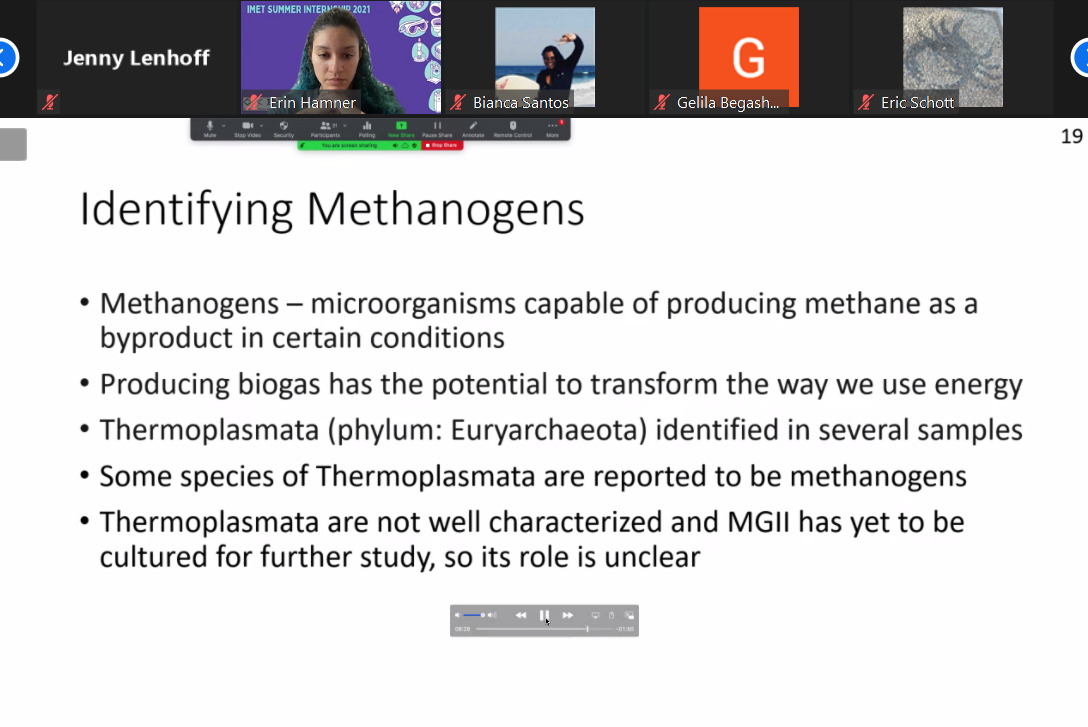
Jenny looked at data collected on several dates from water samples at nine different sites, including around Baltimore City and at less heavily populated sites. She sought to identify naturally occurring methanogens. She found one genus of archaea that has been observed to produced methane, but primarily observed non-methanogenic bacteria. She also found that variation in the diversity of microorganisms correlated more strongly with season than location. Future research might look into the events that caused those changes in microbial diversity.
Altogether, the final presentation day went spectacularly well, with interns showing off their skills as researchers and communicators. Throughout the presentation day, there were many acknowledgment sides and notes of gratitude from the interns, as well as from the faculty advisors and UMCES president. Noted among those thanks were:
- Our funders, whose support makes this program possible: Mary Catherine Bunting, the Venable Foundation, the Charles A. and Lois H. Miller Foundation, and the National Science Foundation
- The faculty advisors: Dr. Rosemary Jagus, Dr. Eric Schott, and Dr. Tsvetan Bachvaroff
- The graduate student mentors: Abdul Adaranijo, Anya Byrd, Paulina Huanca, Lauren Jonas, and Oliva Pares
- IMET and UMCES Staff: Dr. Russell Hill, Monica Gellene, Michelle Prentice, Molly Pickel, and Kurt Florez
- UMCES Integration and Application Network Staff: Dylan Taillie, Annie Carew, Nathan Miller, and Dr. Bill Dennison
- The workshop leaders, Keith Snipes and Dr. Kathleen Gillespie
- All the guest speakers: Frederick Tutman, Donzell Brown Jr, Alice Volpitta, Stephen Bradley, Langston Gash, Charmaine Dahlenburg, Nicholas Coleman, Dr. Micah Miles, Dr. Tamra Mendelson and Veronica Musick, and Shadaesha Green.
Week 7: Almost there!
With just one week to go, the interns were focused on finalizing their analysis and determining how to present the stories they uncovered in their research. While there are five distinct topics, they are interrelated in interesting ways. One of the tasks of the week was to uncover those connections and determine a presentation order that will demonstrate that the whole research contribution is greater than the sum of its parts. For example, one group is studying the Blue Crab diet in Baltimore Harbor and another is studying bacterial and archaeal communities. How do these affect each other? How do these projects build toward a more complete understanding of the urban estuary ecosystem?
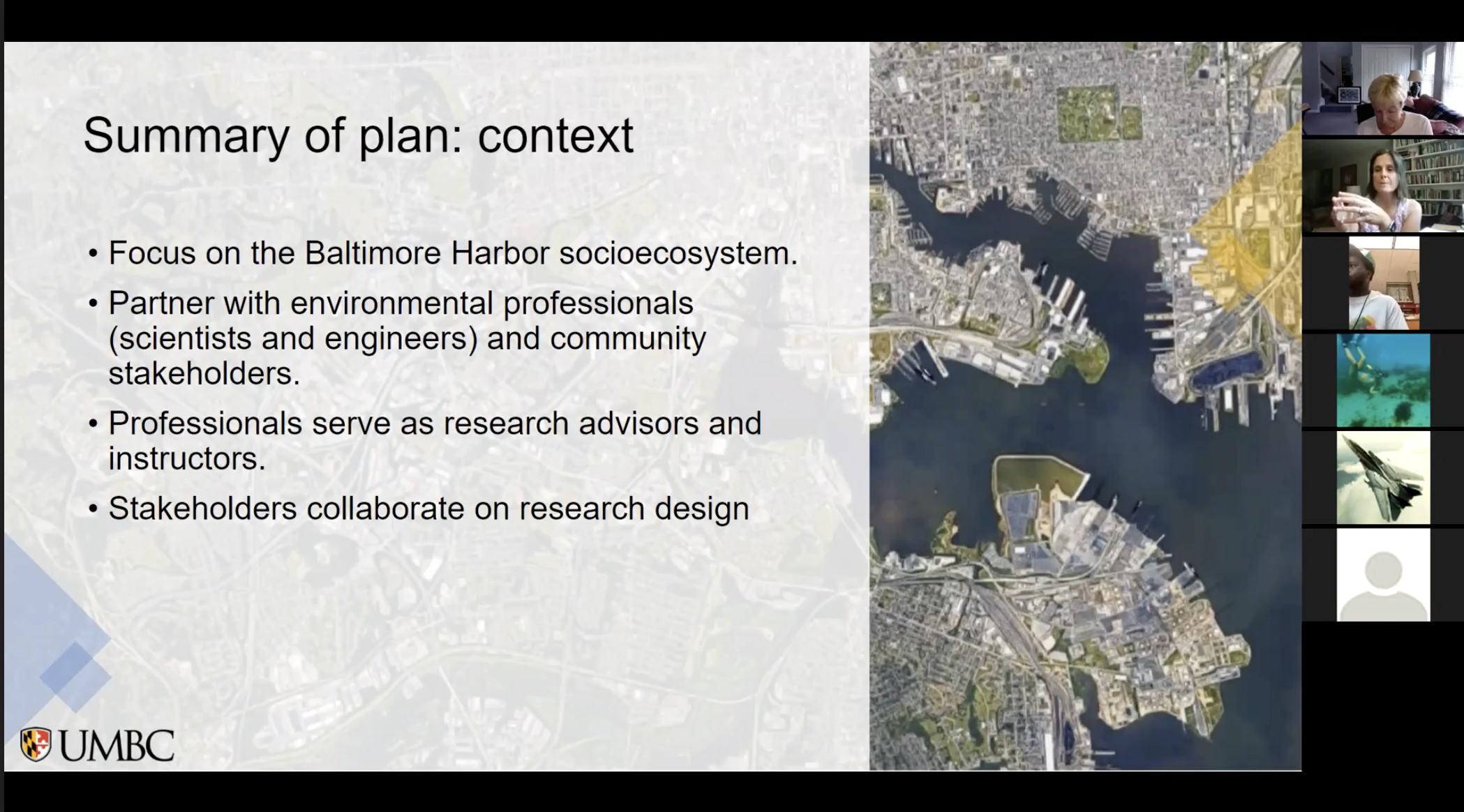
The idea of building a full picture of an urban environment is central to the Interdisciplinary Consortium for Applied Research in the Environment (ICARE) Program at the University of Maryland, Baltimore County. On Tuesday, the interns were joined by Dr. Tamra Mendelson and Veronica Musick, who shared information about this program. Master’s students in the program will study the socioecosystem of Baltimore Harbor. Working across disciplines, they will seek to understand how humans and the environment are interacting. Students will engage with community members and policymakers to ensure that their research is informed by local needs and can be translated into real positive impacts.
The interns are uniquely suited for this program having spent the summer doing research on Baltimore Harbor and meeting with local environmental leaders. In addition, ICARE, like this internship, seeks to increase diversity in the environmental science workforce. Abdul Adaranijo, a 2019 summer intern, a Towson graduate, and current IMET internship mentor, will join the first cohort of the ICARE program this fall. We expect he will not be the last IMET intern to follow this path!
Another path that former interns, including Jeanette Davis, Ammar Hanif, Amanda Lawrence and Shadaesha Green, have followed is to join the prestigious Knauss Fellows. On Friday, we met with Shadaesha Green, an LMRCSC Graduate Fellow at IMET, who spoke about her experience as a Knauss Fellow this year. Shadaesha, or Shae as we know her, is finishing up her PhD in the lab of Dr. Sook Chung studying hormones in crabs.
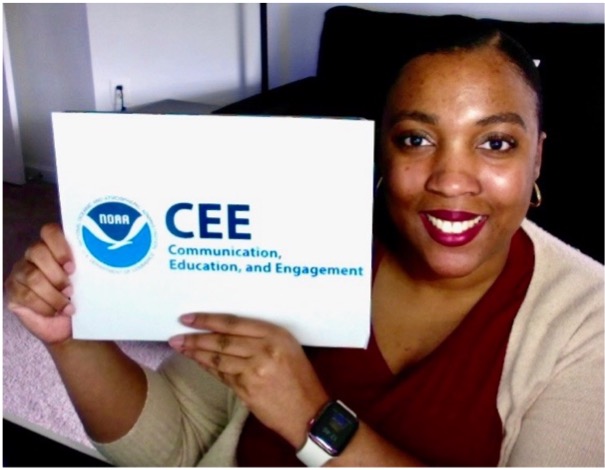
For her fellowship, Shae is working in the Communication, Education, and Engagement (CEE) Division of NOAA as the Risk Team Liaison. The Risk Team includes people working on extreme heat, marine ecosystems, water resources, and coastal inundation. There are major risks in all these areas due to climate change and other factors. As the liaison for CEE, Shae ensures that each risk group can communicate their work to policymakers and the public. Her team prepares briefing sheets so that legislators and the White House are informed about current risks and recommended actions. She said that she is encouraged to use an ABT structure to communicate information and that many at NOAA have taken the same IAN course that the interns had this summer. Once again, the interns have been prepared with some relevant skills for great career opportunities!
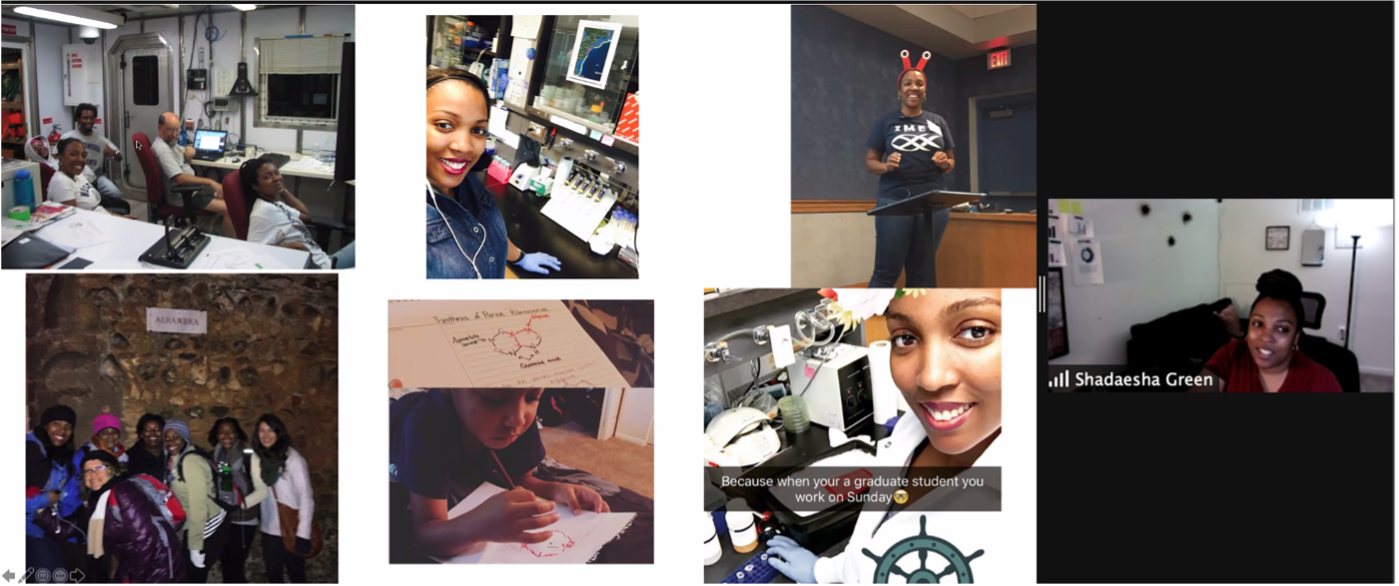
Shae also shared her experience as an undergraduate and graduate student at IMET. Some of the highlights were being able to travel for conferences, presenting her research to others, and gaining experience working with NOAA. For her NOAA Experiential Research and Training Opportunity (NERTO), a component that all LMRCSC fellows complete, she worked in the Chesapeake Bay Office. This experience gave her a window into working with stakeholders, developing skills to communicate with the public, and the impact that science can have on policy. As she continued her education, she knew that she wanted to work with NOAA, leading her to her current fellowship. Next week, we will report back on the interns’ final results and presentations! Check back to learn more about what their summer research can tell us about Baltimore Harbor!
Week 6: What opportunities are out there?
This summer, the interns have learned about various options that are open to them in the future, including graduate school, fellowships, and nonprofit work as scientists and advocates. Sometimes not knowing what career opportunities are out there, or how to get there, can be a big barrier to pursuing marine or environmental science. This week, we sought to remove barriers to pursuing graduate education by sharing information about the process.
The next step for many science students after they complete college is to pursue an MS or PhD. Lauren Jonas, one of the summer internship mentors, summarized her strategy for choosing a place to study as, “Project, Advisor, Place, and Money.” Here’s what she means:
- Project – You need to find a school where you can pursue a project that interests you. For example, after this summer, many of the interns will have expertise in bioinformatics. They may look for places where they can use those skills for their graduate research projects. Lauren discovered her love of marine sponges as a lab research assistant and was able to create a graduate project focused on the sponge microbiome and nutrient cycling.

- Advisor – Lauren said that the advisor is often the single most important factor shaping your graduate experience. The advisor needs to be working in a field related to your interests and have a work and advising style that is appropriate for you. Lauren recommended speaking with potential advisors on the phone and trying to connect with their students to get a good sense of how you will work together.
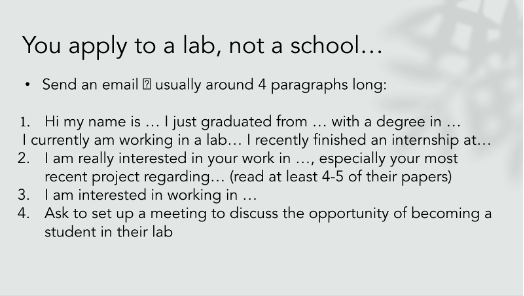
- Place – Lauren shared that one of her deciding factors was the location of the school. A prospective student might consider the place based on their research interests, like whether it is close to study sites of interest, or for personal reasons, like whether it is close to family.
- Money – Lauren said that as STEM graduate research students, the interns should not pay for a graduate degree and should expect a stipend. While some labs have funding available, others may not. Lauren shared resources for fellowships that could support students through their studies. Several interns were enthusiastic about seeking their own funding to make themselves the most competitive candidates for graduate school.
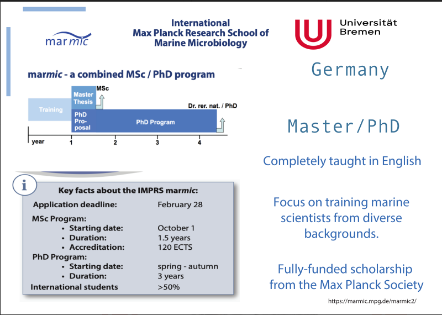
Paulina Huanca, another internship mentor, is from Chile and completed her undergrad there but has since pursued two graduate degrees abroad – in Germany and now in the United States. She shared that graduate school in Europe typically does not include coursework and that a PhD takes three years on average. Many of the interns had never considered doing a graduate degree internationally and so Paulina’s presentation was eye-opening. We won’t be surprised if we soon hear from internship alums studying on other continents!
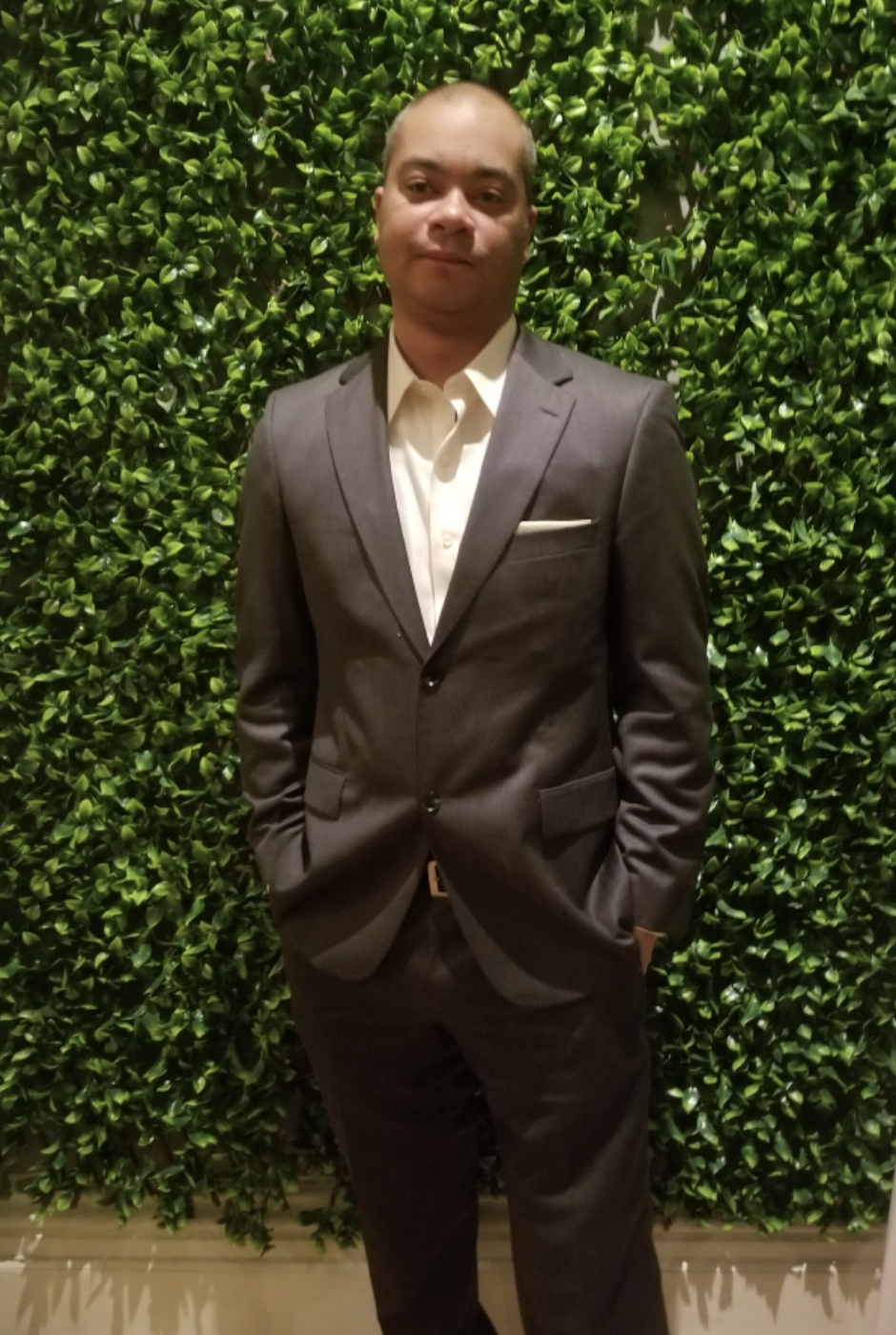
On Wednesday, the interns met with Donzell Brown Jr, the Executive Director and Co-Founder of the Environmental Justice Journalism Initiative (EJJI) and a Commissioner for the Mayor’s Office of Sustainability. He was accompanied by two on EJJI’s summer interns, Priscilla and Zaniya. He presented on the importance of science-informed journalism to fight injustices. With the expertise the interns have developed this summer through workshops with the Integration and Application Network, they are well positioned to contribute to environmental justice efforts through journalism, or other kinds of communication. The conversation covered several environmental justice issues from roads built with disregard for local communities to the connection between storm water sewer backups, poor trash collection services and the economics standing of local neighborhoods. Donzell hopes that, together, our interns encourage print, web, and broadcast the media to shine a light on environmental justice issues. He will be happy to facilitate their connections with different media opportunities now and after the summer internship is over.
On Friday, Keith Snipes joined the interns again for a “gut check” on how they are doing and a discussion of what changes they wish to see in the world. How can our interns, through the science they do, help effect that change? While the interns expressed dissatisfaction and exhaustion with the many current problems of the world, several also shared enthusiasm about their generation’s ability to do better. We came up with a new phrase “Shift happens”. Mr. Snipes left the students with a prompt: “Imagine yourselves a year or more from now when you are actually in the practice of science. What does that look like to you?” Next Friday, the interns will present their vision to the group. “This requires a great deal of imagination,” Mr. Snipes recognized, “but you have a basis for it – you have now.” All the interns are already accomplished scientists doing impactful research.
There are many barriers that minoritized students in the sciences face. One is a lack of access to knowledge about opportunities and how to pursue them, but we hope that through this internship the students will have access to additional knowledge and resources. Another barrier is finding the confidence, but with Keith Snipes’ prompts and the community they have built this summer, we hope that the interns will feel certain of their skills and confident of their science. While we have just two weeks left in the internship, the graduate student mentors, Drs. Jagus, Schott, and Bachvaroff, and our IMET community in general will be available to the interns as they finish college and look onward to new opportunities.
Week 5: Illustrating your work
This week, in between data analysis, the interns had multiple guest speakers. A major focus was on how to illustrate research for different audiences, in visual, spoken, and written forms.
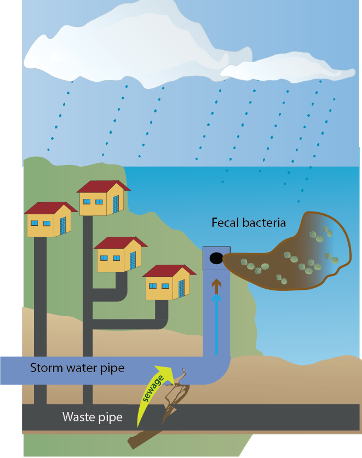
In a workshop with instructors from the Integration and Application Network (IAN), the students learned how to represent scientific observations visually using conceptual diagrams created in the program Adobe Illustrator. Erin Hamner created the diagram displayed to illustrate the central problem that she is working to address: The Baltimore Harbor has fecal bacteria after rainstorms because sewage from homes seeps into the storm water pipes, which feed directly into the harbor. The visual communicates this clearly and illustrates the importance of studying bacteria as part of water quality assessments. All the interns did an excellent job quickly learning the mechanics of Adobe Illustrator and using a symbol library developed by IAN, which includes many of the elements seen in Erin’s graphic. This resource will always be available to them, for use in presentations at conferences, posters, and scientific papers. Their earlier workshop with IAN helped them to develop a narrative story and their more recent workshop gave them the technical skills to present those stories visually.
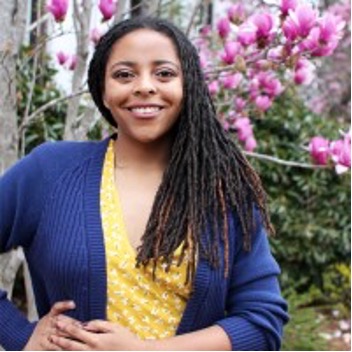
On Tuesday, the interns met with Dr. Micah Miles, who is the Environmental Program Manager for the Waterfront Partnership, an organization devoted to improved maintenance, beautification, and visitor services for Baltimore’s waterfront. Dr. Miles recently earned a PhD in Integrative Conservation at the University of Georgia. She also does videography and artist feature content for The Biota Project, whose mission is to “to uplift everyone in our communities as scientific stewards through education and outreach.” Discussion topics included how to choose a graduate school program, the opportunities for scientists to work in non-profits, and how cool reptiles and amphibians are. It was especially exciting for the interns to meet with Dr. Miles because some of them are examining data that she has helped to collect. The Waterfront Partnership takes measurements of key indicators like bacteria counts and gathers data on the amount of trash collected each year by the iconic Mr. Trashwheel.
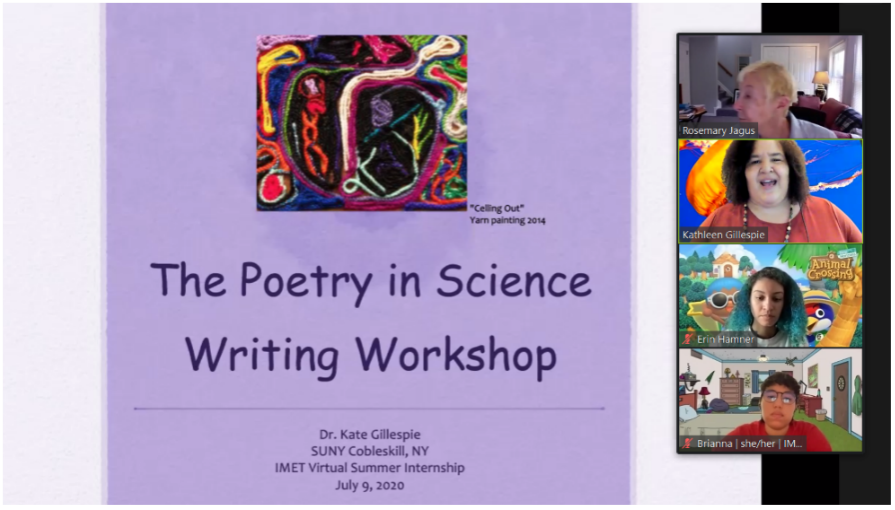
On Friday, Dr. Kathleen Gillespie, who completed her PhD at IMET and who is now an Assistant Professor at SUNY Cobleskill, led the interns through a writing workshop on “The Poetry in Science.” While Dr. Gillespie has made her career in science, she has always written poetry as her creative outlet and has been published in several collections of poetry. She shared how it has enabled her to pique the curiosity of non-scientists and encouraged them to ask questions about what scientific terms mean. For example, she shared a poem she wrote about the process of translation of genetic material within a cell.
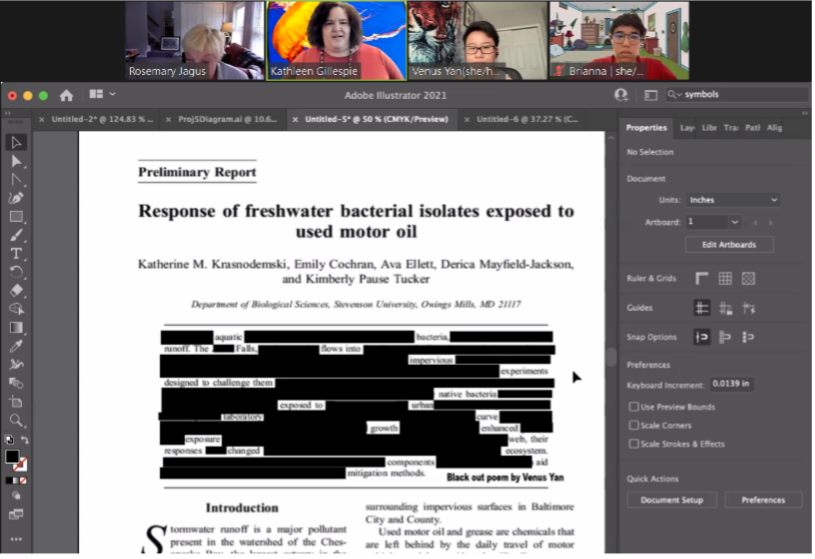
Students were soon asked to try their hand at writing scientifically inspired poems. For one set of poems, the interns used terms from their project as well as terms they associate with science and poetry. Among the science terms were theory, question, discovery, beaker, and test tube. Among the poetry terms were art, emotional, dramatic, and symbolism. While these terms demonstrate the many differences between science and poetry, everyone found some benefits from combining the two fields. For the second exercise, the interns took the abstract of a scientific paper and created a “subtractive poem,” where some words are removed to reveal a poem. In this way, the poetry of science is gradually revealed. Venus’ subtractive poem took the paper, “Response of freshwater bacterial isolates exposed to used motor oil” and turned it into a thoughtful, lyrical poem.
Everyone flexed their creative muscles during this workshop. That was more natural and comfortable some interns than for others, but for all, Dr. Gillespie’s workshop demonstrated that there are fun and productive ways to bridge art and science.
Week 4: Easy as A-B-T!
This week featured another stellar lineup of guest speakers as well as focused independent work on research projects. On Tuesday, the interns workshopped their “And, But, Therefore” statements to describe their research projects with IAN. Each student’s description reflected their deepening understanding of the science of their work and the most effective techniques for science communication. In addition, IAN scientists guided them into using the graphics software Adobe Illustrator.
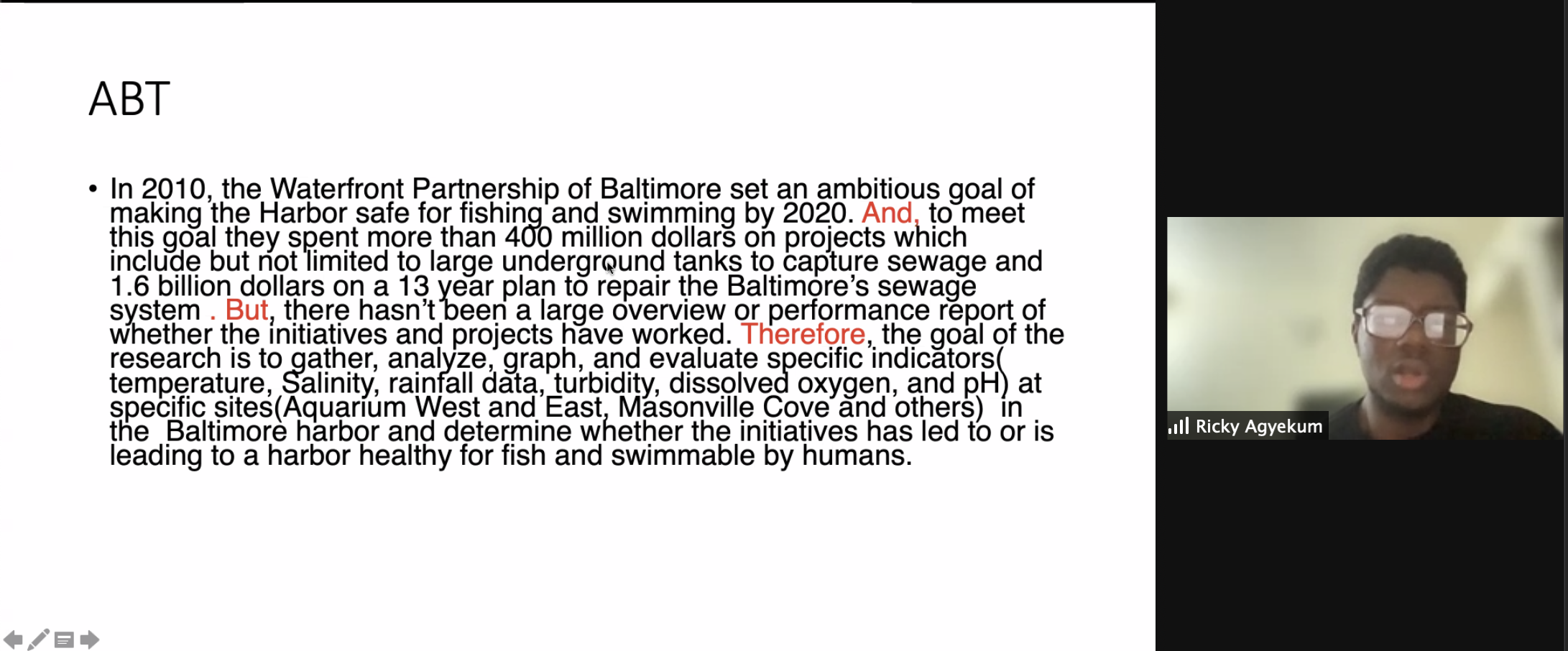
Ricky set a great example for the group with his ABT, which clearly laid out the problem that his research seeks to address: Over $400 million have been spent on improving Baltimore Harbor’s water quality, but there hasn’t been an assessment of its efficacy. He and his research partner, Erin, are addressing this gap by bringing together different datasets and analyzing different indicators of water quality. Ricky will work next week on condensing his statement to communicate just the most important information.
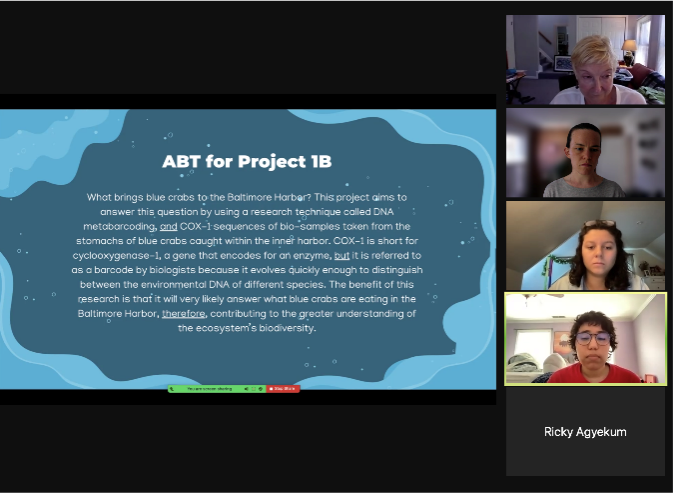
Brianna Gomerez, who is analyzing DNA data from Baltimore’s Harbor, effectively communicated the impact of her research, saying, “The benefit of this research is that it will very likely answer what blue crabs are eating in Baltimore Harbor, therefore contributing to the greater understanding of the ecosystem’s biodiversity. Now, she and her research partner Bianca Santos are hard at work identifying different marine species based on their DNA sequences.
On Wednesday, the interns were joined by two speakers from the National Aquarium: Charmaine Dahlenburg, Director of Field Conservation, and Langston Gash, Conservation Aide and former IMET intern. They work on a variety of estuarine conservation issues and this week, they presented specifically on the harbor biodiversity project. To sum up this project in an ABT: The National Aquarium wants to improve the water quality and biodiversity of Baltimore’s harbor and they believe that floating wetlands could address these issues, but measureable data is needed to know if technology is making a difference. Therefore, they joined forces with IMET, the Baltimore Under Ground Science Space, and citizen scientists to create baseline data and monitor the ecosystem going forward. This summer, Bianca and Brianna are a part of this mission.
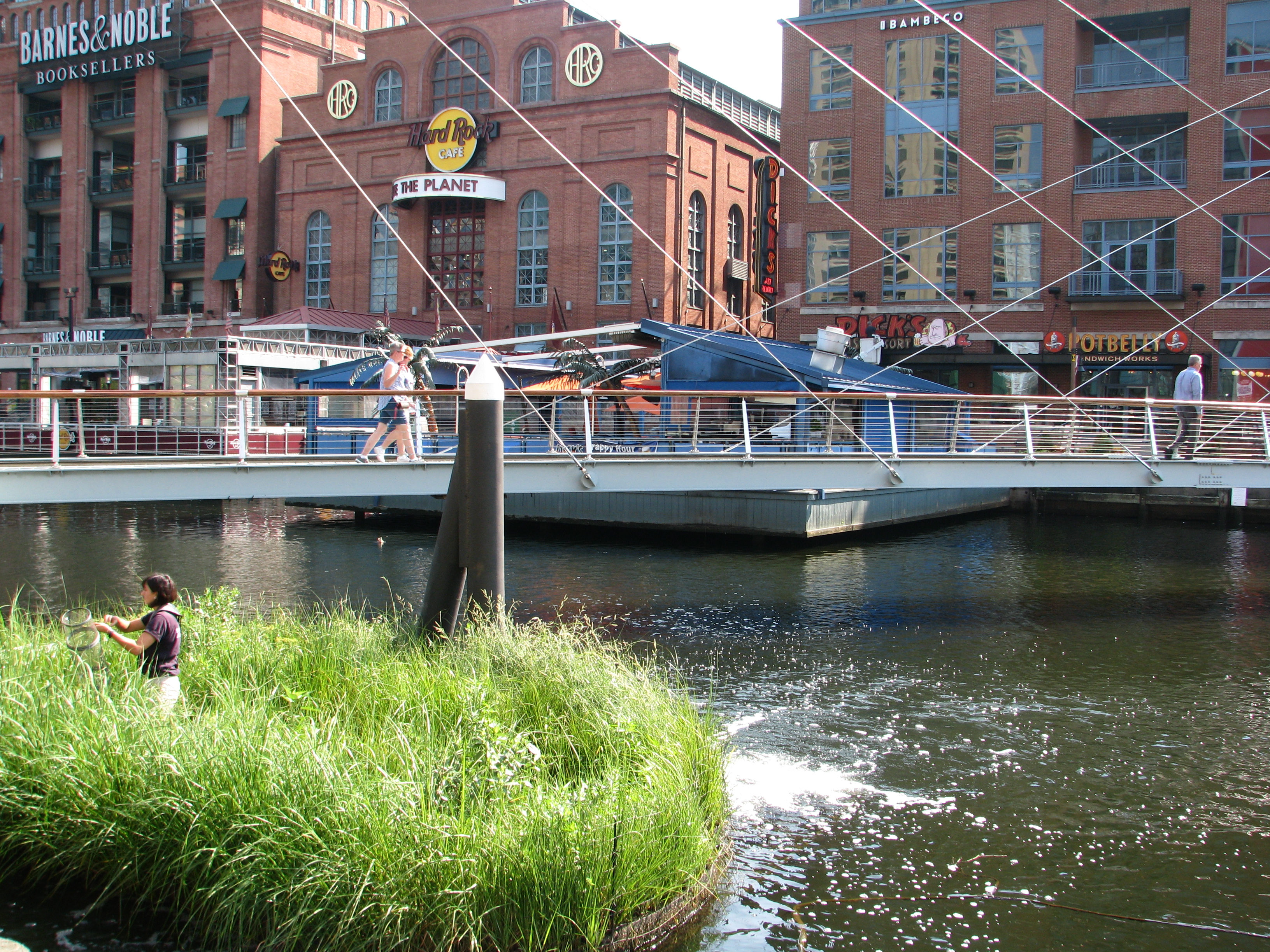
Charmaine and Langston described the long process of developing a good prototype floating wetland and their vision for the entire space between the Aquarium’s two piers to be filled with wetland life. Langston shared his path from IMET intern in 2018 to member of the Aquarium’s conservation team. His work includes a mix of scientific research, interaction with the public, and a lot of time spent in the field, whether on a boat inspecting floating wetlands or at a citizen science “BioBlitz.” For some of this year’s interns, this sounded like a perfect combination of responsibilities to include in a career.
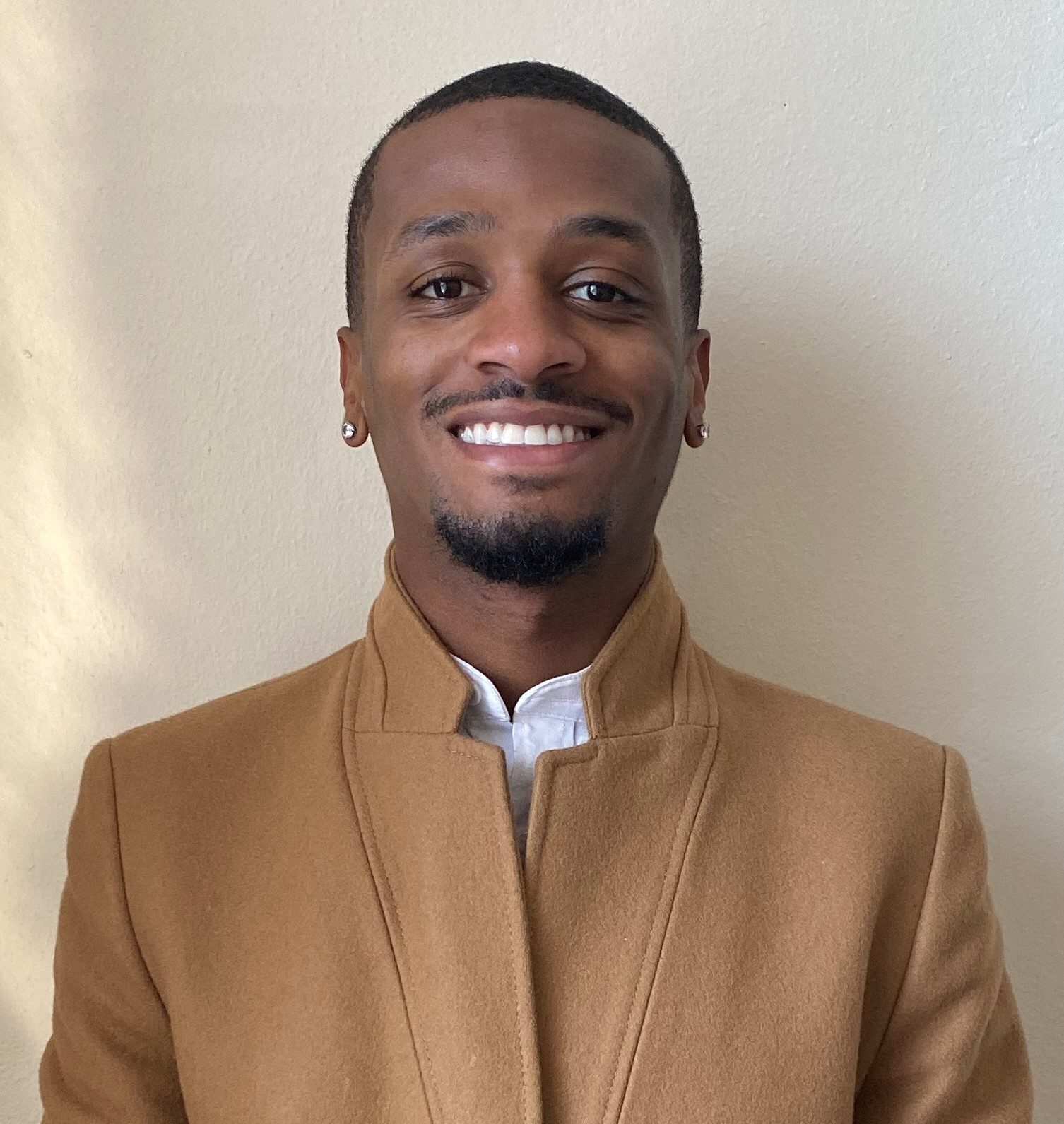
On Friday, the interns met with Nicholas Coleman, who is a Graduate Research Assistant with Dr. David Secor at the Chesapeake Biological Laboratory and a participant in the NOAA-funded Living Marine Resources Science Cooperative Center (LMRCSC), which aims to increase diversity in marine science and policy. To summarize his thesis work in an ABT: Atlantic sturgeon, thought to be extinct in the Chesapeake, were recently re-discovered here and we want to know more about the population in the region. But, current research methods make it hard to estimate populations of species under water. Therefore, Nicholas is developing newer acoustic methods to learn more about the range and life history of Atlantic sturgeon in the Chespeake Bay.
Nicholas called into the Zoom session from Northern California, where he is studying a different sturgeon species, green sturgeon, as part of a research opportunity between the LMRCSC with a NOAA fisheries lab. The interns asked Nicholas about his research and NOAA experience, as well as about the process of applying to graduate school. With several seniors in the group, many interns are thinking about how to continue their science research interests. In a couple of weeks, they will have a session focused on graduate school applications with current students and faculty and continue this discussion. Stay tuned!
Week 3: Building skills and understanding
As the interns get more familiar with their projects, week 3 provided an opportunity to learn more about their data and how to analyze it. While they are not able to be in the lab this summer, practicing processes like DNA extraction and amplification, they can learn how to use the information gleaned from such lab techniques. Lauren Jonas presented information about how DNA sequencing is done and what it can tell us. Olivia Pares, who had already introduced data analysis techniques last week, hosted extra sessions for interns to troubleshoot and hone their skills. Finally, a Friday session with Stephen Bradley, Associate Professor of visual arts at UMBC, reinforced the importance of being able to communicate environmental issues to a wide audience.
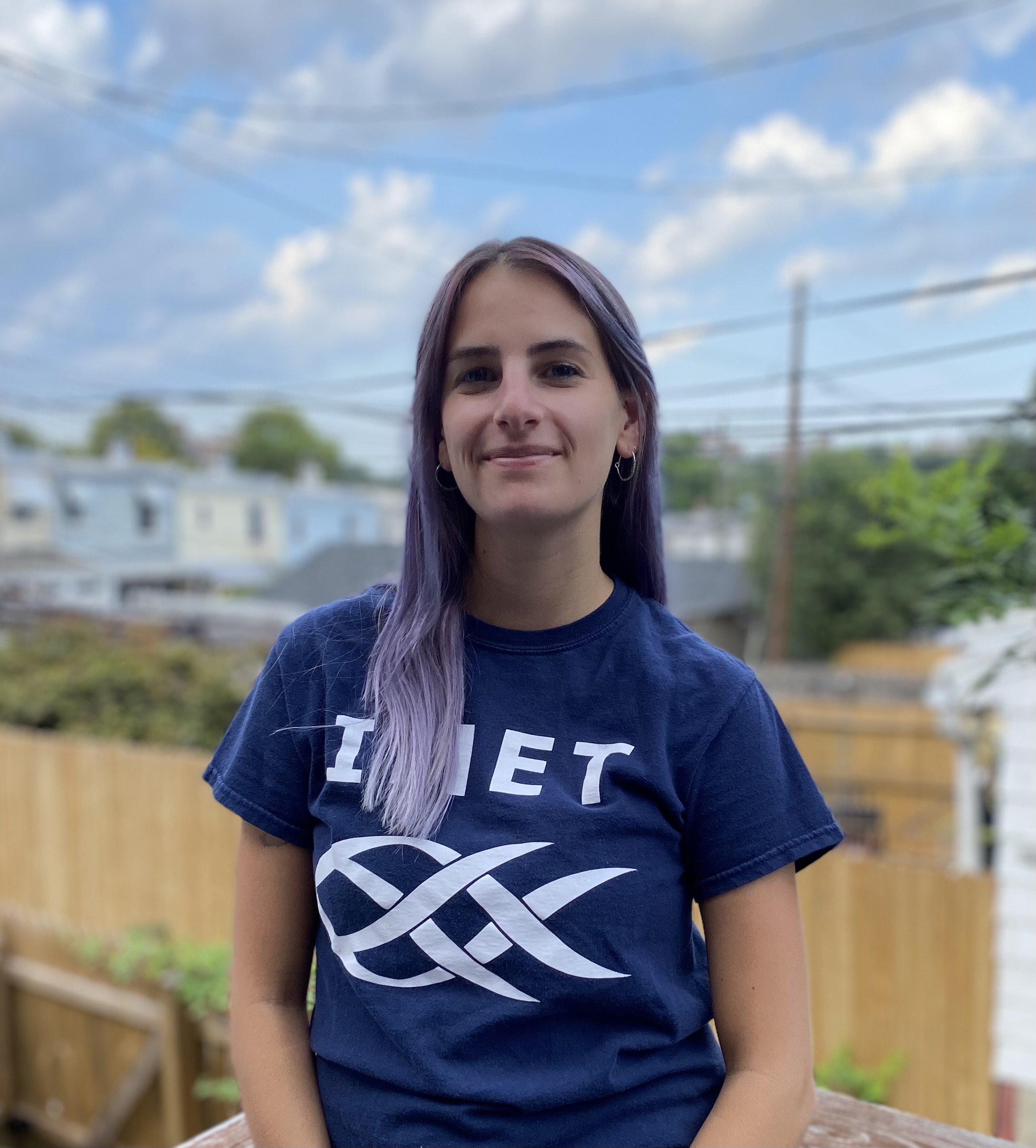
Lauren Jonas is the mentor for Gelila and Jenny for the project, “Bacterial communities, archaeal communities, and the urban estuary.” During week 2, she presented on eDNA and DNA barcoding. In this process, an environmental sample like water or water is processed to return DNA sequences. Like a barcode at a store, the DNA can be used to identify different organisms that were present in the sample’s environment. Many of the interns’ projects use this kind of data from Baltimore Harbor.
This Monday, Lauren joined again to define some terms that provide the basis for interpreting DNA data. For example, she provided an overview of the difference between prokaryotes and eukaryotes and how that is reflected in their RNA. While many interns may be familiar with such terms from their biology courses, Lauren’s presentation demonstrated how vital that understanding is to their research methods.
Olivia Pares is the mentor for Bianca and Brianna for the project, “Inner Harbor biodiversity and blue crab diet.” She is also a largely self-taught expert in R, a statistical analysis program. All the interns have a huge amount of data available to them, but the challenging part is making sense of it. Olivia has been holding extra help sessions to help the interns import, organize, and visualize their data. Brianna said, “R is frustrating, but once you get it and you see the code work out, I feel like everyone has a moment when you're really happy about it.” This sentiment was shared by everyone in the group. Olivia will continue to help the interns as they develop their R skills throughout the summer.
Lauren, Olivia, and all the mentors’ guidance has helped the interns make great progress in just three weeks. On Friday, everyone updated the group on the work they have done and their tasks for the coming weeks. Many of the interns were revising their “And, But, Therefore” statements and familiarizing themselves with R and other programs like Qiime and USEARCH. Bianca and Brianna are reviewing underwater videos taken in Baltimore Harbor to generate data about the relative abundance of various organisms and Myia is working on identifying trends and outliers in her data on the enzyme mTOR in the blue crab. After Lauren’s presentation on terms, each intern is also researching a term to present to the group. At this point, everyone is fully immersed in their projects and doing excellent work.
On Tuesday, the interns met with Alice Volpitta, the Baltimore Harbor Water Keeper working with Blue Water Baltimore. Blue Water Baltimore has a water quality monitoring program that collects scientifically rigorous and legally defensible water quality data. Their mission is to protect and restore Baltimore Harbor and the greater Patapsco River to make our waters suitable for fishing and swimming, improve public health, and improve the health of the river ecosystem. Alice helped put in perspective the inadequacies of the City’s aging sewage and storm water systems. Since the two systems are in close proximity to each other, sewage from cracked and leaking sewer pipes enters the storm water system which drains directly into local streams. This not only puts harmful bacteria into the harbor but also adds nitrates and phosphates, leading to the dinoflagellate blooms. Alice also put in perspective the importance of the analysis being undertaken by our interns Ricky Agyekum and Erin Hamner.
The interns capped off the week with a Friday session with Stephen Bradley, who is on the faculty at UMBC and will be the artist-in-residence at IMET in Fall 2021. Throughout his career, he has brought attention to environmental issues through art. In one project, he catalogued litter in a town, treating it as archaeological evidence. He remarked, "It’s amazing how much stuff we create that's not meant to last." Through art shows, he has engaged people in thinking about how long waste lasts in the environment and how much there is. Next fall, he will work with scientists at IMET to create a mobile science lab for Dr. Eric Schott and his collaborators to bring to sites around the harbor. This will help them collect data relevant to many of the interns’ projects and engage with members of the public passing by.
Next week, the interns will continue their hard work on individual projects and present progress reports to the group. They will continue a focus on learning to communicate their work with another workshop with the Integration and Application Network, focused on visualization software. With just three weeks complete, everyone has already learned so much!
Week 2: Who inspires you?
Last week, Keith Snipes asked the interns to research a scientist who inspires them. He encouraged the interns to find someone who shared elements of their identity – race, gender, country of origin, and/or field of study. The resulting presentations were very diverse – from Black scientists born in the 1920s to Latinx researchers just a couple years older than the interns themselves. Despite their knowledge, brilliance, and drive, all the scientists faced common barriers of discrimination. They nevertheless carried out impactful science research and are great role models. Each of the scientists chosen was individually impressive and inspiring. The choices also tell a story of what drives this group of interns. The chosen scientists researched the biggest issues of their time and of their communities, from HIV to bilharzia, heart failure, and newborn mortality. A strong focus of the contemporary scientists chosen is on climate change and the ways it will affect the most vulnerable. In choosing their scientists, the interns showed a strong sense of obligation to use their science to serve people and promote social and environmental justice.
The focus on environmental justice was strengthened by a meeting with Donzell Brown, Jr, Executive Director of the Environmental Justice Journalism Initiative (EJJI) and Frederick Tutman, Patuxent River Water Keeper and member of the board of EJJI. EJJI seeks to create a more engaged and informed community around environmental inequities and to address them to build a more equitable future. EJJI is working with students around Baltimore to help them to tell environmental stories from their perspective and connect them with resources for careers in a variety of fields that touch on environmental justice.
Part of using science to help diverse communities includes ensuring that our interns can be effective science communicators. Communication was another focus of this week, as the interns participated in their second Science Communication Workshop with UMCES’ Integration and Application Network (IAN). In this workshop, the interns focused on building simple “ABT” statements about the research they are doing this summer. ABT stands for And, But, Therefore. By using these three conjunctions, scientists can show the motivation and impact of their work. For example, Venus wrote, “Insects serve an essential ecosystem service in the food chain and aid in pollination for the reproduction of plants and fruits. But colony collapse disorder or mass die-offs of native beneficial insects are visible due to the implementation of broad-spectrum pesticides in agriculture. Therefore, scientists need to engineer insecticides specific to the insect pest species and preserve the native insect biodiversity.” As the interns progress this summer, they will frame their research in terms of ABT statements, helping to communicate their work to a wide range of audiences. Check back for more updates and ABT statements about research happening in the IMET Summer Internship program this summer!
Below are the scientists that each intern presented on. Maybe you’ll be inspired too!
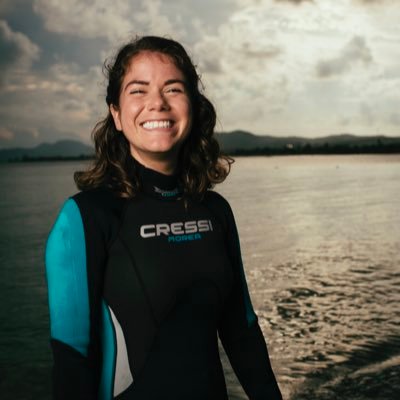
Melissa Cristina Marquez
Presented by Bianca
At just 27 years old, Melissa Cristina Marquez has already accomplished a lot. She received her master’s degree studying bycatch of sharks and related species and has become a public figure talking about the need for representation of women and minoritized groups in STEM fields. Bianca related to her as a Latina scientist, a SCUBA diver, and an advocate for others. Bianca was impressed by all of Melissa Marquez’s achievements and said, “If she can do it, I can do it, and so can many other women in this field.” Bianca recommended watching a TED talk where Melissa Marquez explains what female scientists and female sharks have in common.
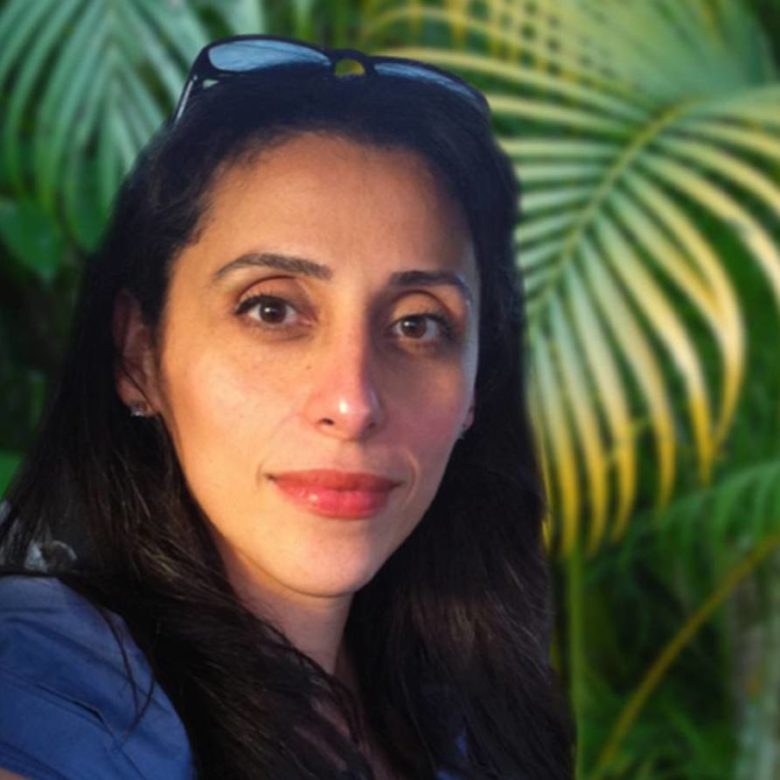
Nicole Hernandez Hammer
Presented by Brianna
Nicole Hernandez Hammer is a female Guatemalan American who focuses on rising sea levels, especially in Florida, where she lives. Brianna was particularly inspired by her because of the work that she’s done connecting big issues like climate change to public health concerns affecting Latinx communities and other people of color. Brianna said, “Science doesn't need to be all facts and numbers … there should be a compassionate and human part to it that involves environmentalism and activism that touches people's hearts.” Nicole Hernandez Hammer’s work exemplifies a compassionate and activist approach to science. Brianna recommended watching a clip from "Years of Living Dangerously,” where she explains the impact of sea level rise on Miami residents.
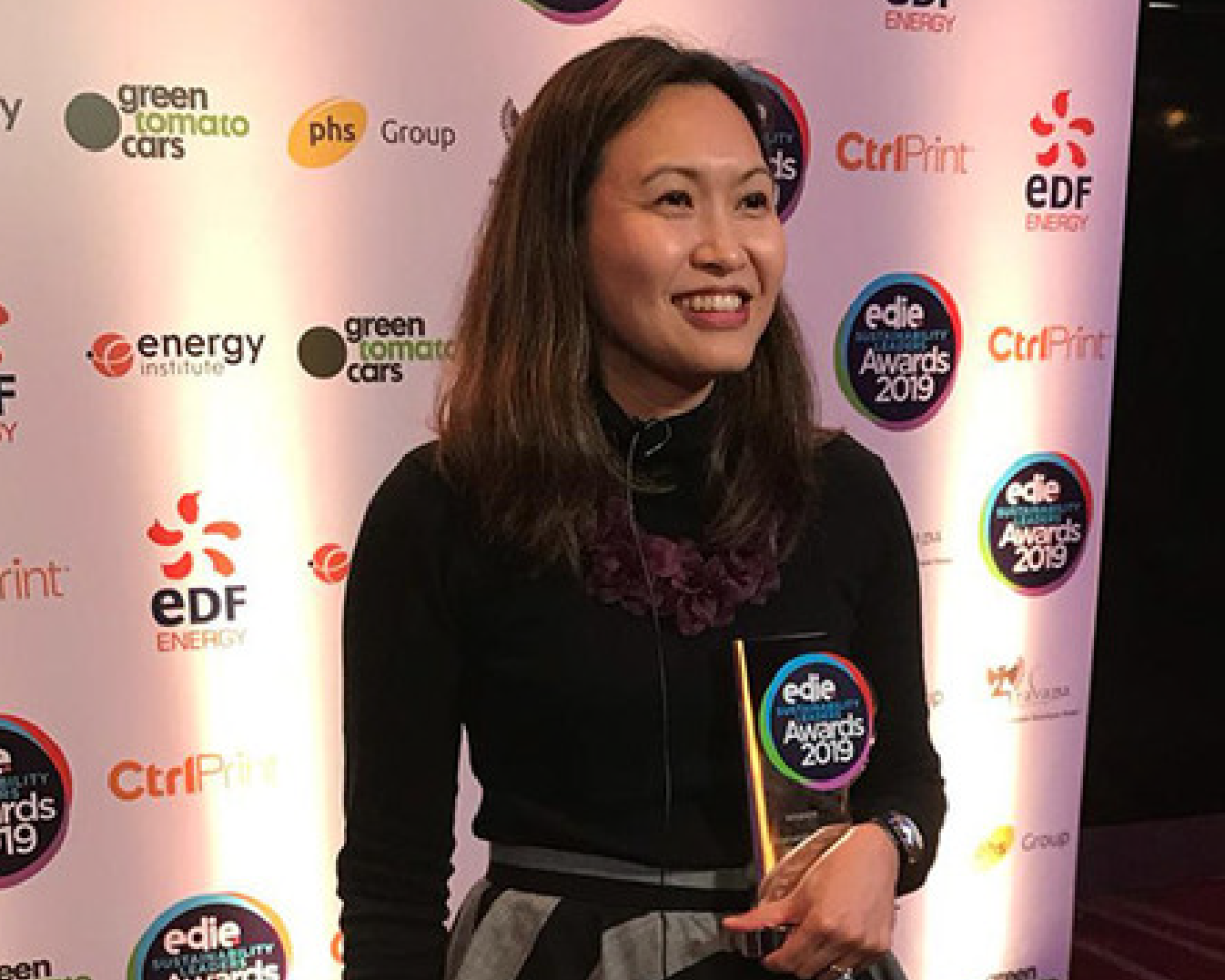
Janice Lao
Presented by Lizi
Janice Lao is a scientist, development economist, and mom who has made great strides toward sustainability. She was raised in the Philippines, where Lizi’s father emigrated from and recently was the first Asian and the youngest person to win the Edie Sustainability Leader of the Year Award. Lizi was inspired by Janice Lao’s determination to advance environmental goals and the fact that she took all the opportunities available to her, just as Lizi’s family has encouraged her to do – leading her to this internship this summer!
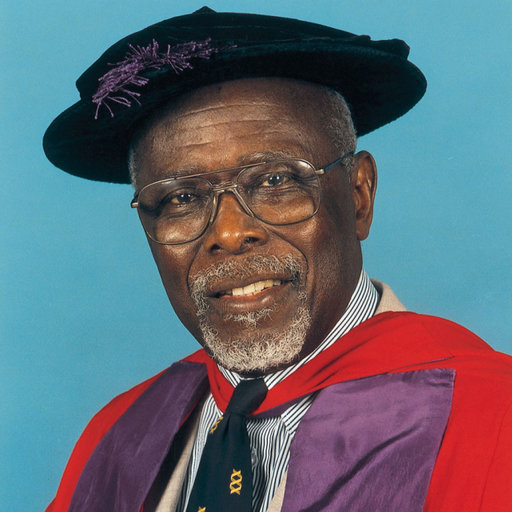
Felix Israel Domeno Konotey-Ahulu
Presented by Ricky
Dr. Felix Israel Domeno Konotey-Ahulu is a Ghanaian scientist and physician, who grew up before Ghana was founded as a nation. He was educated in England, studied sickle cell anemia, and returned to Ghana to practice medicine and teach. He has been named to a list of the top 100 most influential Africans. As a Ghanaian-American and an aspiring doctor, Ricky related to Dr. Konotey-Ahulu and hopes that he will also be able to return to Ghana in his career, using his medical skills to help communities there.
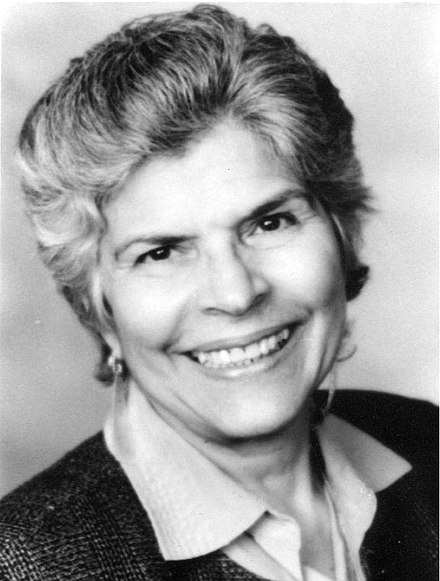
Helen Rodríguez Trías
Presented by Jenny
Dr. Helen Rodríguez Trías is a Puerto Rican pediatrician, public health expert, and activist who advocated for advancements in medical care for those whose access was limited. She fought for legislation to abolish forced sterilization, established a newborn clinic in Puerto Rico that reduced newborn death by 50%, and supported women and people of color who were infected with HIV. Jenny was inspired by all the leadership roles she held outside of her primary job as a pediatrician and hopes that her career can have similar broader impact.
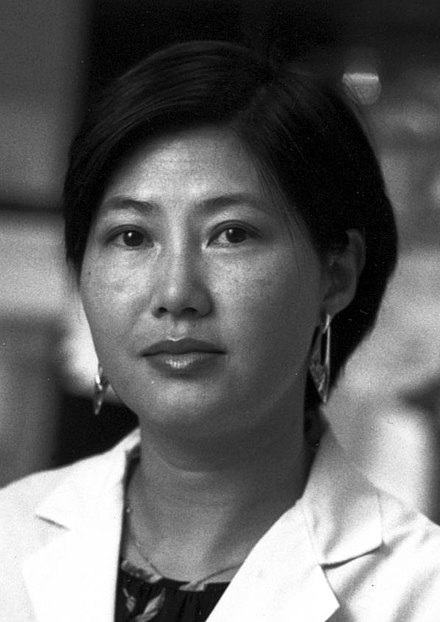
Flossie Wong-Staal
Presented by Venus
Dr. Flossie Wong-Staal was born in Guangzhou, China in 1946. After fleeing from China during the Communist Revolution, she eventually found her way to the University of California, Los Angeles. A virologist and molecular biologist, she made major advances in the study of HIV and was the most cited female scientist of the 1980s. Like Dr. Wong-Staal, Venus is the only member of her family to receive a higher education and speaks Cantonese, which is often looked down upon by Mandarin speakers. Venus was glad to learn about such an accomplished scientist who shared some personal identities with her.

Otis Boykin
Presented by Eric
Like Eric, Otis Boykin was interested in aviation and aerospace. He was an inventor and received patents on 26 devices, including components for missiles and computers. Though he had to drop out of graduate school because he could not afford it, Otis Boykin continued to collaborate with former professors and applied his creative mind to a variety of contemporary challenges. He is most famous for inventing a part of the pacemaker, which has saved many lives. Eric, who is still deciding on a major for college, was inspired by the breadth of Mr. Boykin’s inventions.
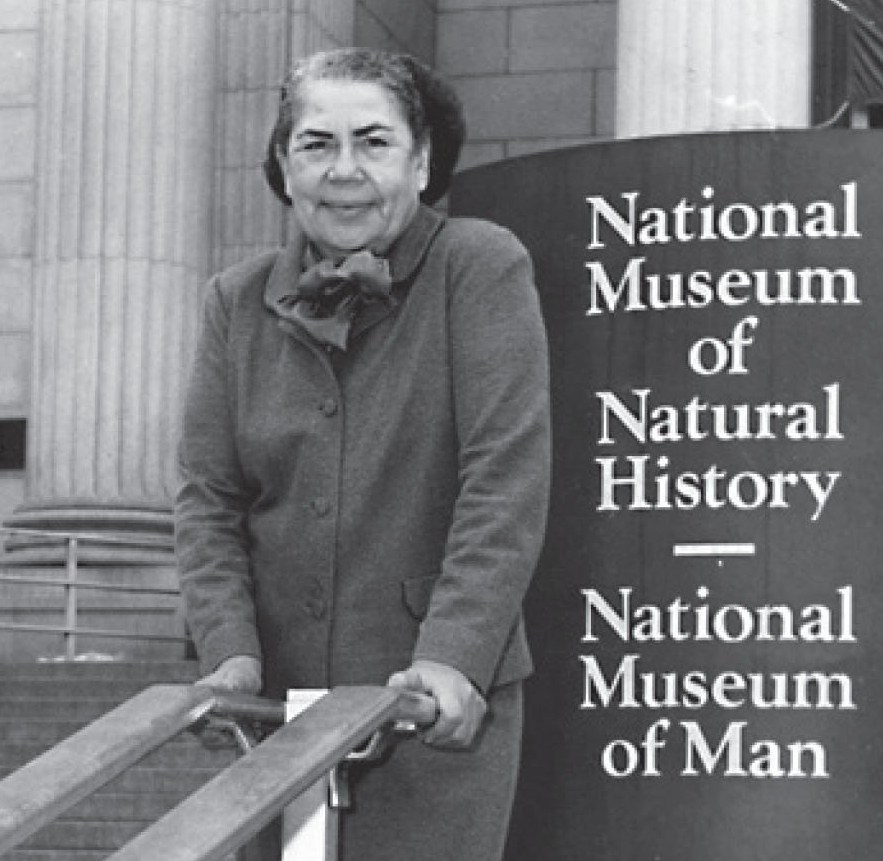
Margaret James Strickland-Collins
Presented by Myia
Dr. Margaret James Strickland-Collins, born in 1922, was an African American entomologist and only the third woman to earn a Ph.D. in the field of Zoology. While working at FAMU and Howard University, she was an advocate for racial equality. Myia related to the way that she found ways to serve others throughout her career – as an activist, a teacher at HBCUs, and volunteer. Myia already considers herself a hands-on, activist student and plans to give back to her community in her professional life.
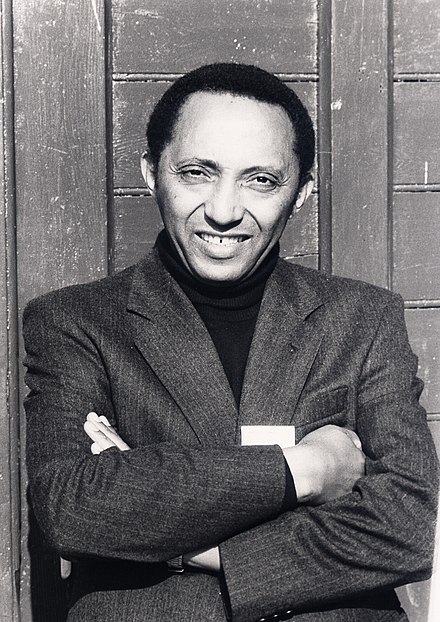
Aklilu Lemma
Presented by Gelila
Dr. Aklilu Lemma was a scientist who studied bilharzia, which is the second most economically destructive parasitic disease, next to malaria. It is found in parts of South America and Africa, including Ethiopia, where both Dr. Lemma and Gelila were both born. He studied the potential of endod, a plant already used in Africa as a soap, to prevent bilharzia. When he presented his research to the WHO, he was denied funding because of discrimination against non-Western universities, yet he managed to push through further studies of the plant. Gelila was inspired by Dr. Lemma’s perseverance and the impact that he had on society.
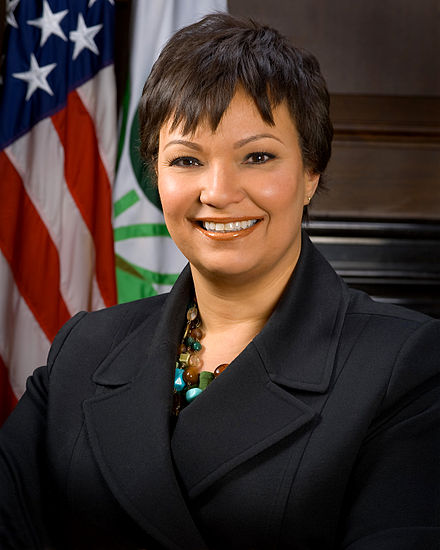
Lisa Perez Jackson
Presented by Erin
Lisa Perez Jackson is a chemical engineer and was the first African American administrator of the EPA, where she advocated for stricter air and water quality standards. Erin is similarly interested in promoting clean water, especially in urban areas, through research and science-based policy. Lisa Perez Jackson now works for Apple, where she led the initiative to make Apple carbon neutral for corporate emissions and is currently advancing efforts to become fully carbon neutral, eliminate plastic packaging, and reduce freshwater use.
Week 1: What helped you get here today?
This first week of the IMET Summer Internship has been a flurry of activity with presentations from IMET scientists, a workshop on science communication, and hitting the ground running with research projects. On Friday, however, the group of interns took time to reflect on what helped them get to this point where they are conducting advanced independent science research projects.
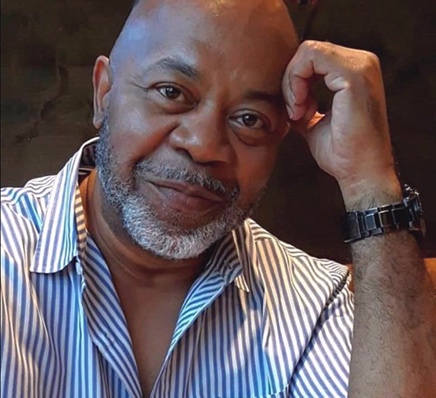
The group discussion was led by Keith Snipes, who is a Baltimore native and actor. He shared his personal journey to his current role. Coincidentally, he was first exposed to acting as a participant in a City summer program when he was a teen. He had never experienced theater before but was thrown into it by chance. He found that he enjoyed acting and had a talent for it. Over the years, he found success in the field and then decided to take on a new challenge of acting in Shakespeare plays.
When he first auditioned for a Shakespeare play, he found that he was one of a very few black actors on stage. This caused him to doubt whether he could succeed and whether he would be accepted by castmates and audiences. Nevertheless, with encouragement from others, a confidence in his acting skills from past performances, and a lot of determination, he found a love of Shakespearean acting.
While the interns are working in an entirely different field, many of them found points of connection to Mr. Snipes’ story. Several shared moments when they felt others were skeptical of their scientific abilities or when they didn’t see any others in the lab who looked like them in terms of race or gender. These moments created a sense of doubt about whether they could succeed, even as they showed an aptitude for science. This is a common feeling, especially among minoritized and female students, and is often called imposter syndrome.
Despite moments of doubt and discomfort, every one of the interns in this program found a way to move forward and pursue their interests. Mr. Snipes asked each intern what helped them on this path. Several mentioned family members – a parent or sibling who believed in them throughout moments of uncertainty. Myia said that, after years of being bothered by others’ doubts, she made a conscious decision to not care and find strength in herself and her parents. Eric shared that others’ doubts were motivating, as he felt a strong drive to prove people wrong. Venus and Brianna said that they created a sense of belonging for themselves when they met or learned about scientists of similar identities.
This internship is designed in part to create an environment where students can gain confidence, build a diverse scientific network, and talk about issues like imposter syndrome. In future weeks, the interns will learn a great deal about their projects, working with data, and creating scientific presentations. This week’s discussion and future Friday discussions will help create the foundation on which that stands – a foundation of confidence and community.
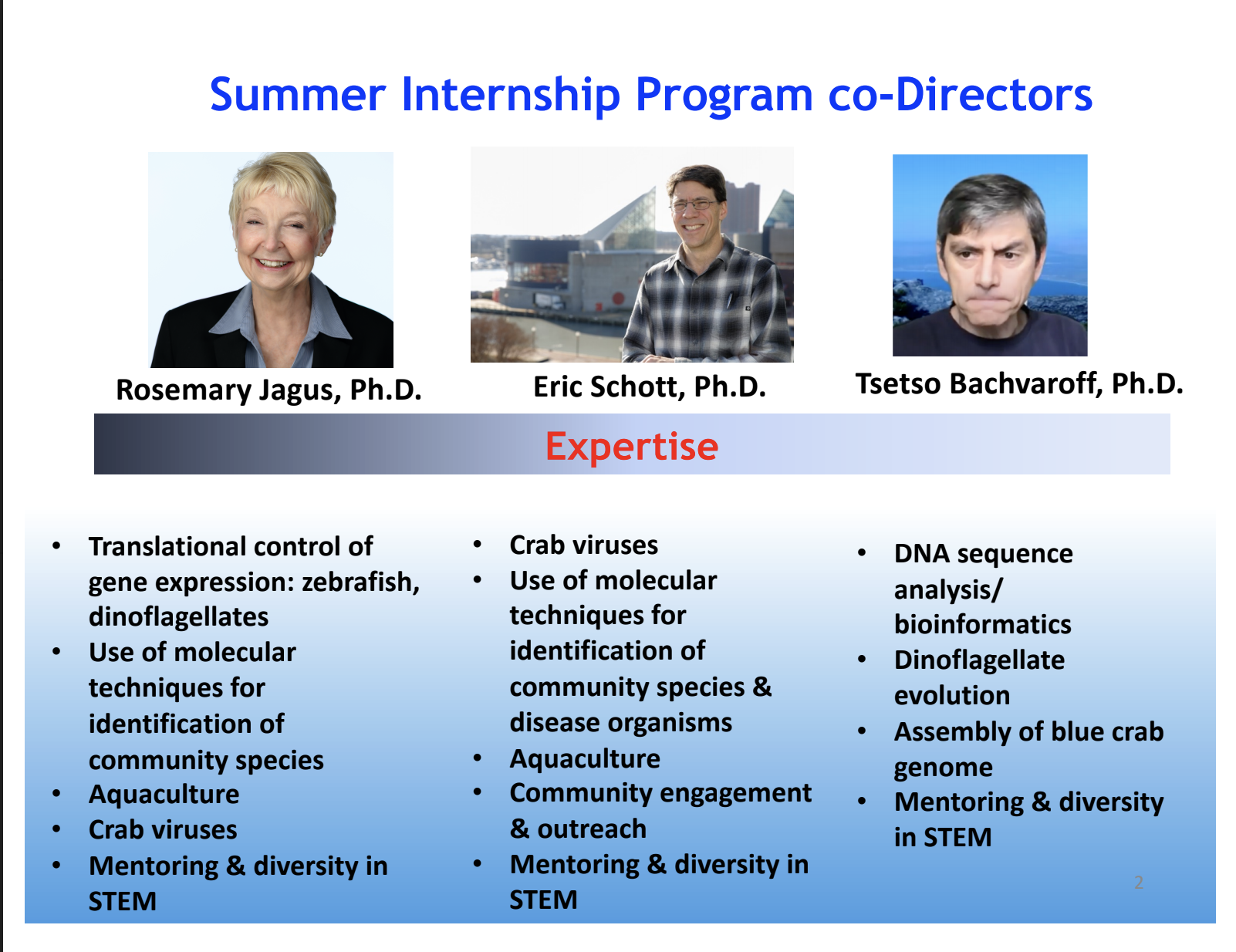
Research Projects
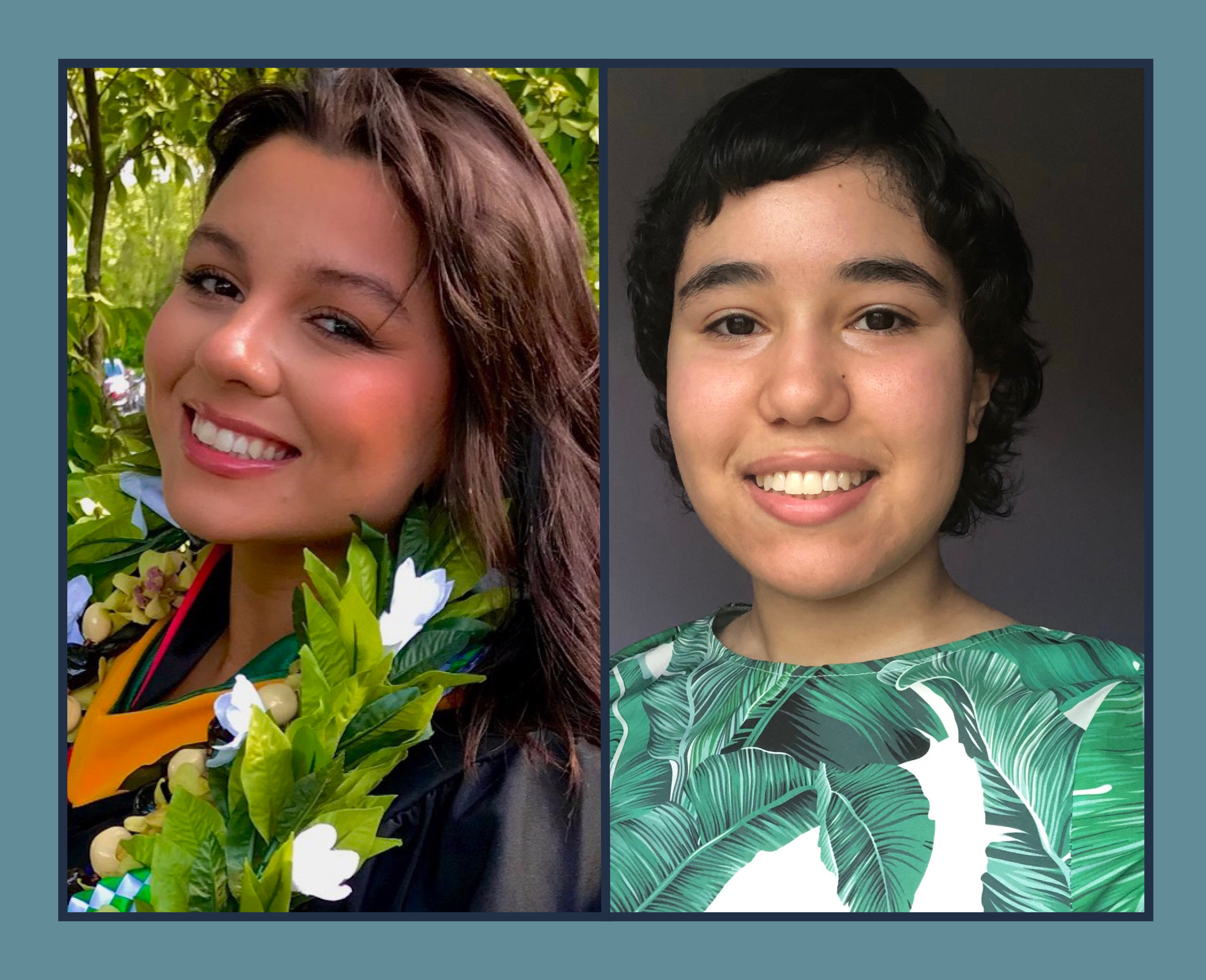
Inner Harbor biodiversity and blue crab diet
Bianca Santos and Brianna Gomerez
Advised by: Eric Schott and Olivia Pares
Blue crabs, striped bass, menhaden, and other aquatic life visit Baltimore Harbor every summer. They are not here by accident. This is evidence that the Harbor functions as a habitat. What are the crabs here for? Do migratory animals find forage in this estuary? Using DNA metabarcoding data, we will catalogue the potential food items that live here and determine what blue crabs eat in the Harbor.
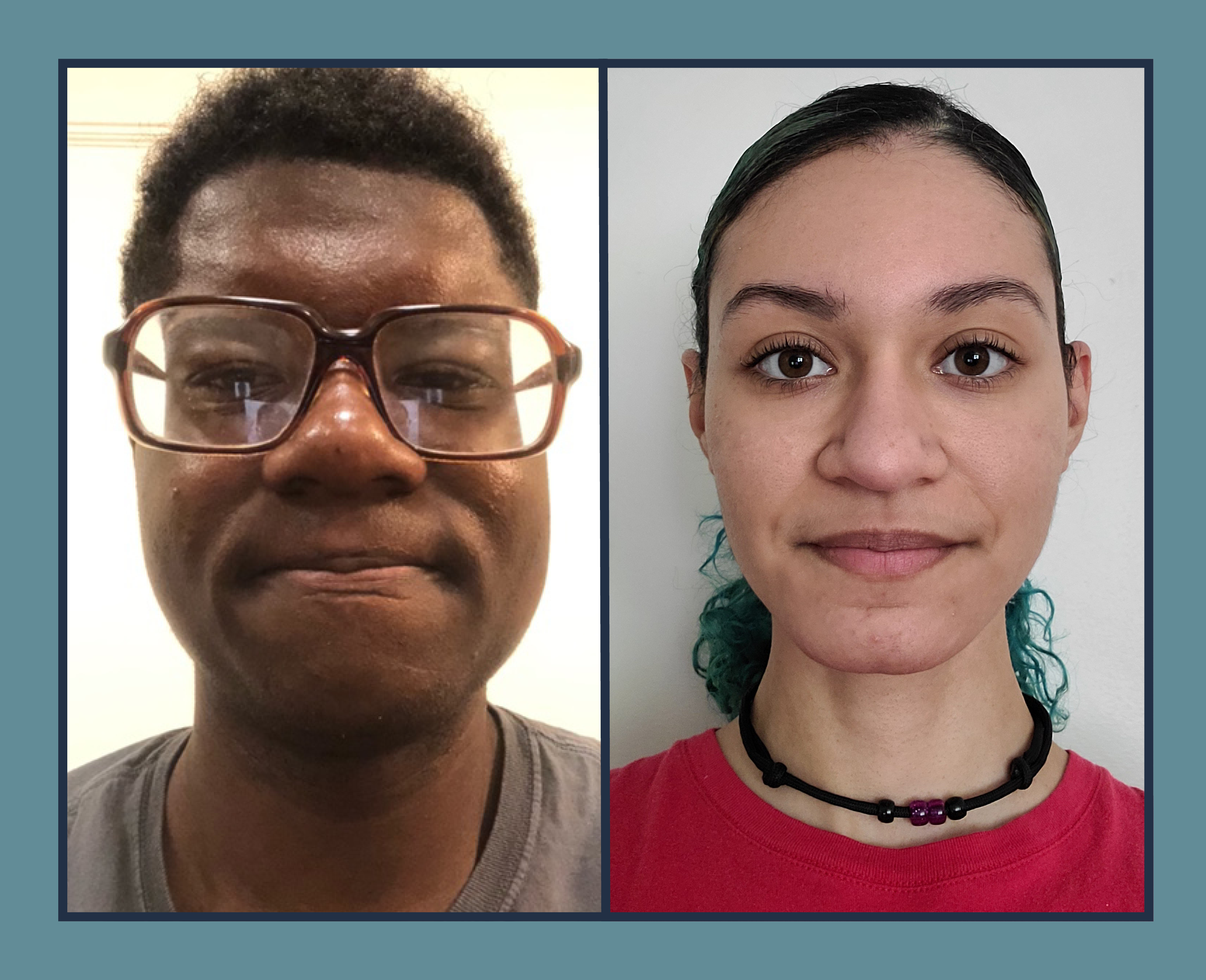
Ricky Agyekum and Erin Hamner
Advised by: Eric Schott and Abdul Adaranijo
In 2010, the Waterfront Partnership and other stakeholders set a goal of making Baltimore Harbor swimmable and fishable by 2020. In that decade, major improvements to sewage infrastructure and trash removal were made, but have they made the harbor safe for swimming? Is the harbor a healthy habitat for fish? Using water quality data including bacteria counts, we will build a better picture of the health of the harbor.
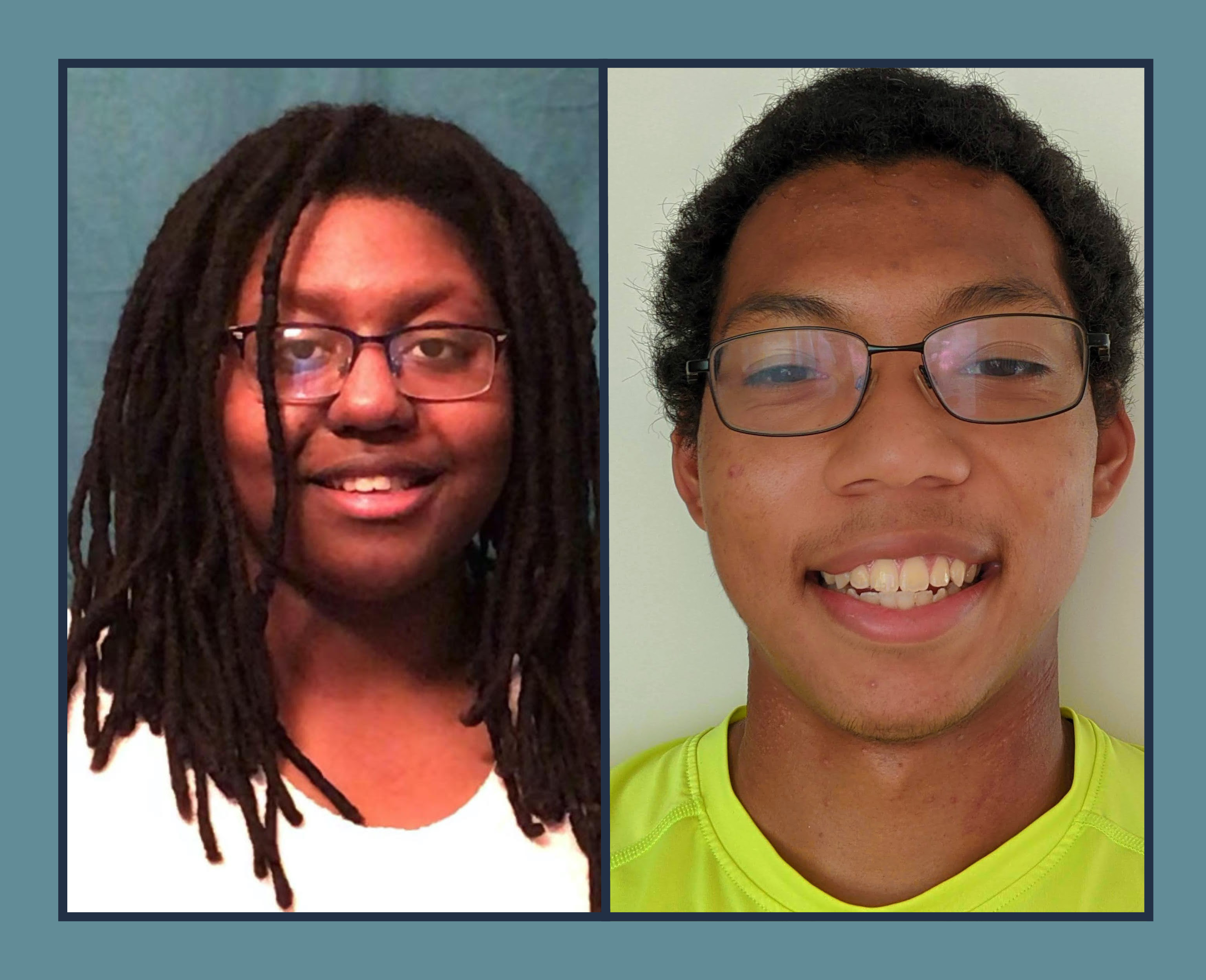
Myia Robinson and Eric Sibanda
Advised by: Tsetso Bachvaroff and Anya Byrd
The enzyme mTOR is a major cellular regulator of growth in animals and responds to nutrient and anoxic stress. It has been identified in the blue crab. This project will use the unique genome resource of the blue crab assembled at IMET by Dr. Sook Chung, Dr. Tsetso Bachvaroff and other IMET scientists. Interns will work with a transcriptomic oxygen stress response dataset.
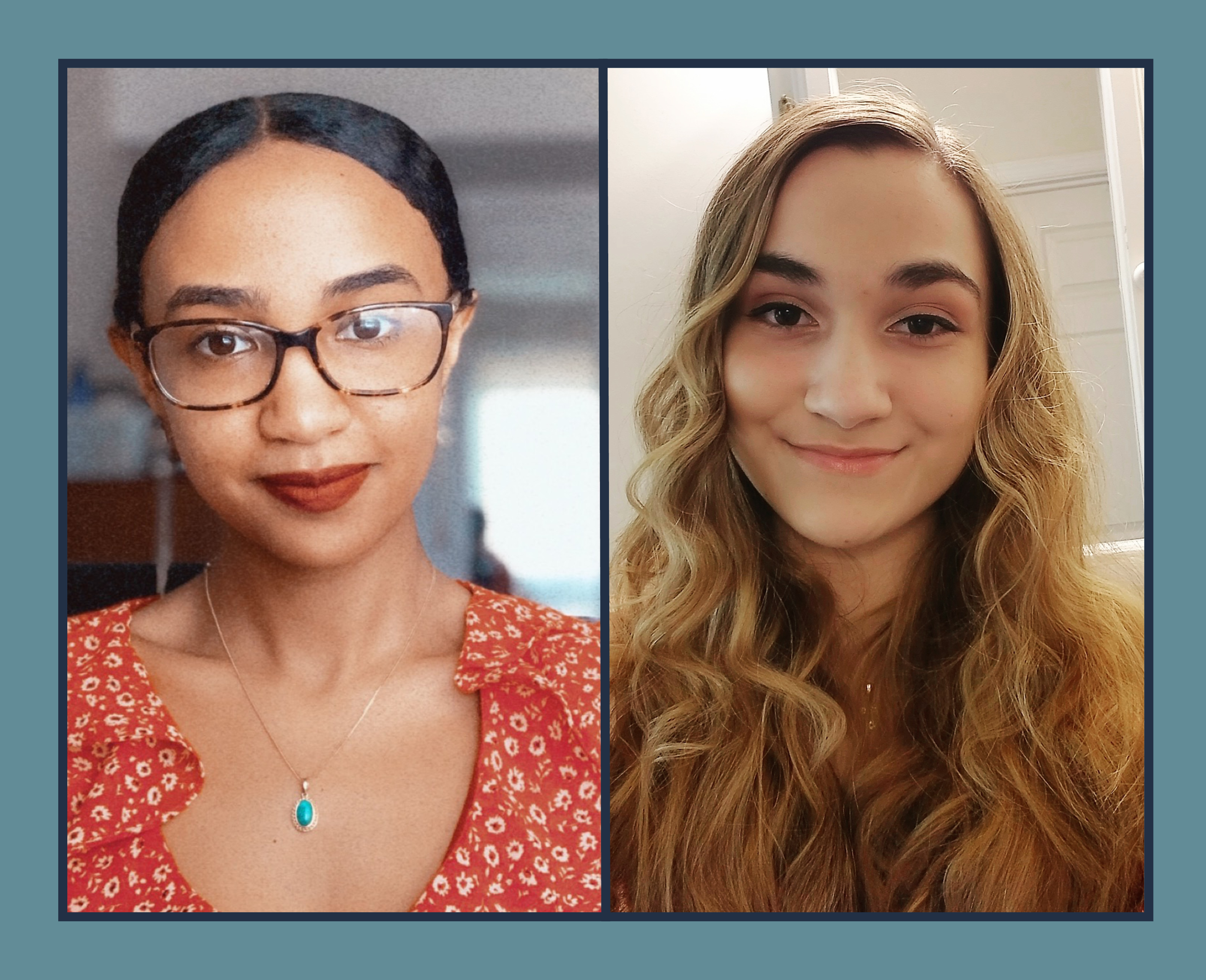
Gelila Begashaw and Jenny Lenhoff
Advised by: Tsetso Bachvaroff and Lauren Jonas
Some microorganisms produce methane, which can be used as a biofuel. This project will use DNA metabarcoding datasets to determine if there are methane-producing or sulfur cycling microorganisms present in samples from water close to human habitations, in open water, and in chicken manure.
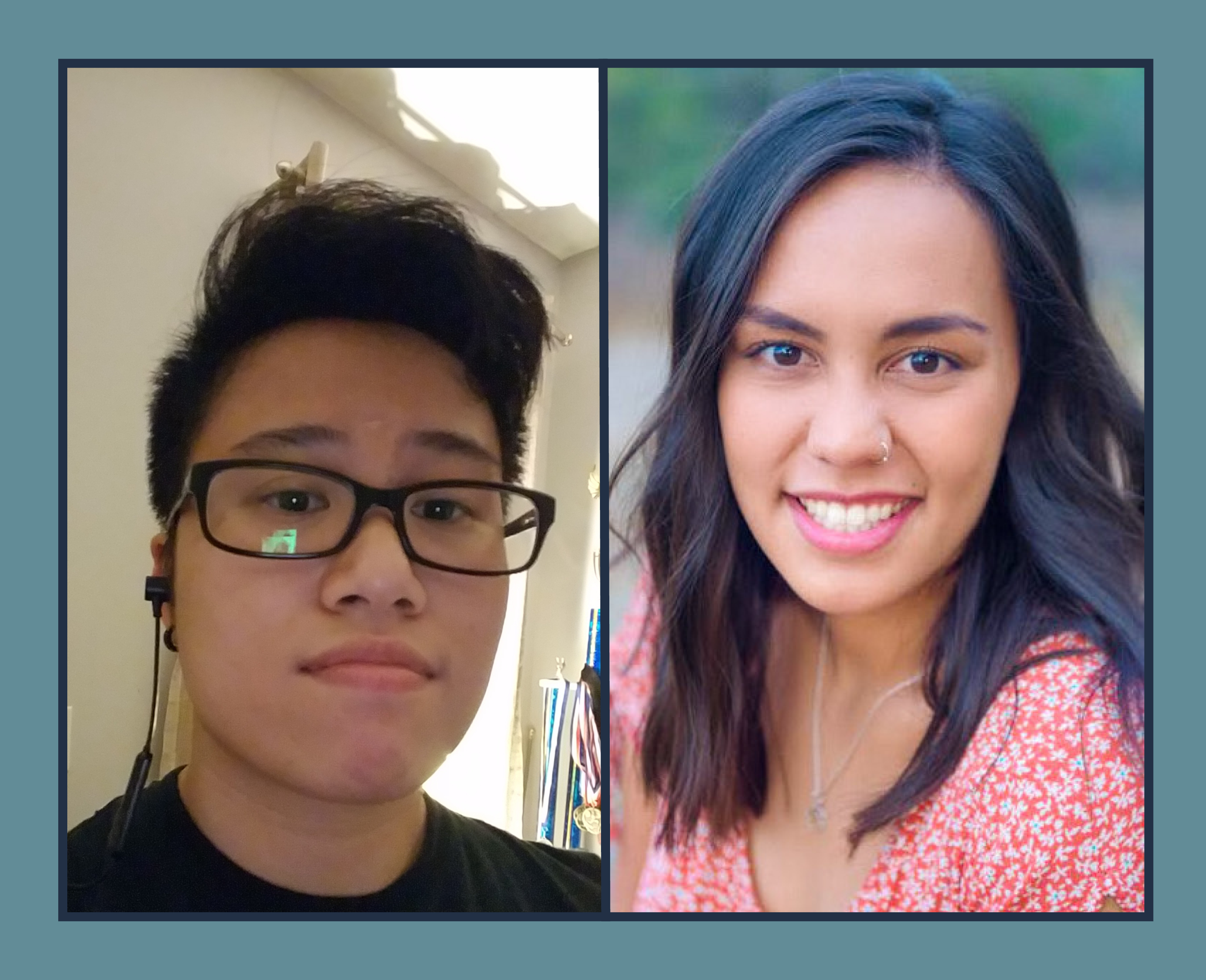
Venus Huang and Lizi Cudal
Advised by Paulina Huanca
Microbial communities are important to the maintenance of life on earth. In aquatic systems, they are involved in the biogeochemical cycling of key nutrients. The composition of microbial communities is influenced by environmental conditions. Using DNA metabarcoding data, we will look into microbial diversity in the open ocean and compare it with microbial communities in the Baltimore Harbor.


